BRITAIN ON THE HIGH SEAS
Heroic Endeavour
 CHARLES WALLROCK
CHARLES WALLROCK



Wick Antiques Ltd, Riverside Business Park. Gosport Street, Lymington, Hampshire SO41 9BB Mobile: 07768 877069 Showroom: 01590 677558
Email: charles@wickantiques.co.uk
Website: www.wickantiques.co.uk

BRITAIN ON THE HIGH SEAS
CHARLES WALLROCK
 Heroic Endeavour
Heroic Endeavour

Foreword
This book, Heroic Endeavour , is our tribute to all those who work to save lives at sea, especially the Royal National Lifeboat Institution’s brave crews, tireless fundraisers and supportive families – in particular those from the Lymington crew, where our son Edward is a volunteer. In the 200 years since its inception in March 1824, the RNLI has saved more than 140,000 lives at sea and tragically lost more than 600 lives in the process. The first section of this edition contains medals for gallantry, a silver lifeboat model, painted wooden models, oil paintings, designs and photographic records, all relating to the RNLI.
The second part of the book concerns the Royal Navy with particular reference to the great Trafalgar battleship HMS Bellerophon and continues to a watercolour of World War I destroyers engaged in a ‘Moonlight Scrap’ . The third section features commercial shipping from open fishing cobles and luggers to steam cargo ships. Finally, we celebrate the recreational enjoyment derived from humble Thames rowing boats to state of the art America’s Cup racing yachts.
Caroline Wallrock, author of Britain on the High Seas: From Nelson to Churchill, Britain on the High Seas: Trafalgar, Trophies and Trade, Britain on the High Seas: Merchants and Mariners and Britain on the High Seas: Wars and Wealth.
Saving Lives 1834-1938
Captain Thomas Stuart R.N.’s Medals for Gallant Service
1833 Model of the Tyne lifeboat by Thomas Young
1837-8 Captain Thomas Green’s Medals for Heroic Conduct at Sea
1852 The Duke of Northumberland’s silver lifeboat by Garrard & Co.
1861 J.N. Carter: Scarborough Tragedy of Lifeboat
Amelia
1862 Lugger lifeboat model Twyman
1871 Model of the St Michael’s Paddington
1888 Model of the Huddersfield II.
Thomas Rose Miles: Hastings Beach
1896 Thomas Bush Hardy: In Distress off Staithes, York
1894 Clayton Archive: City of Glasgow
Penarth Lifeboat Station
RNLI designs, albums, slides
1915 Lifeboat plans by G.L. Watson & Co.
Designs for Zinita
Yacht model: Coquette
1931 Scale model of a Watson class lifeboat
Bassett-Lowke model of a motor lifeboat
Naval Heroes 1784-1951
1784 Dominic Serres: Formidable, St. Albans, Belliguard and Swift
1790 John Adams barkcloth
A battleship snuff box
Table of Contents 2 4 10 18 16 22 12 14 20 8 6 28 26 32 24 30 36 34 38 40
42 43
Ed Wallrock, crew member, Lymington lifeboat
A bone model of Creolian
1799-1819 A pair of Cary 21 inch globes
1801 The Lobster and the Crab pipe rest
1805 Bellerophon Chair
Painting by Thomas Luny
Pryce Cumby salver
1813 Admiral Duckworth’s silver tray
1811 Nicholas Pocock: Emerald with a painted wooden model
Equine portraits of Marengo and Copenhagen
Victory spirit barrel
Admiral Lord Nelson window
1873-1957 Silver rowing trophy sculls
1914-1918 Montague Dawson: A Moonlight Scrap
Commercial Vessels and the Victorian Age
1840 Clarkson Stanfield: Gulf of Salerno
1812 Four mariner’s fids
Anglo-American whaler fid
Montague Dawson: Wind Aft: The Repulse
Tiller with Queen Victoria’s likeness
1832 Clock with Queen Victoria’s Ball Costume
1840 Andrew Morton: Captain G.T. Scobell
1886 Lt. Colonel B.L.J. Scobell’s silver cup
Model of a Thames Wherry
Model of a Hastings Lugger
1893 W.L. Wyllie: Newbiggin Bay
Henry Scott: Clipper South Australian
1853 Model of Nathan Thomson’s seat
American half hull of a yacht tender
1914-17 Flag from Shackleton’s Antarctic Expedition
1912 Model of S.S. Burbridge/S.S. Burcombe
Brass bell from P&O Liner Ballarat
A working model of boat on davits
1934 Model of Lord Cochrane
1934 Model of S.S. Mervyn Yacht Racing
1829 Royal Yacht Club silver-gilt trophy 1846 Silver-gilt Lyme Regis & Charmouth Cup
1851 Attrib. T. S. Robins: The Schooner Yacht America
1851 Model of America by G.L.Watson
1868 New York Yacht Club trophy by Tiffany & Co.
1872 The Gracie Cup by Tiffany & Co.
Model of a racing sloop
1903 Thomas Willis: Shamrock III versus Reliance
1899 Shamrock life ring
1930 Harold Wyllie: Shamrock V versus Enterprise
Montague Dawson: Taking in the Jib
pages 16-17
pages 12-13
pages 66-67
pages 60-61
3 back cover front cover front endpapers back endpapers 48 46 52 44 50 54 53 56 60 59 64 58 62 72 70 76 69 74 80 78 84 82 86 90 89 94 88 92 98 96 95 102 100 108 106 112 104 110 116 114 117 66 68 118
Captain Thomas Stuart’s Medals for Gallant Service 1793-1840

This very fine group of four medals was awarded to Captain T. Stuart, Royal Navy, who was recognised for his part in the Syria operations of 1840, having already earned two Royal National Institution Lifesaving Medals for acts in his native Ireland, besides the reward of a Lloyds Sword for saving the Hannah in 1829. They are mounted in a fitted, blue velvet lined, oak display box by Hunt & Roskell. Each medal is in a fitted recess and the two for saving lives from shipwreck have their citations recorded on brass plaques above them. The lid has a handle with the brass plate engraved ‘Captn. Thomas Stuart R.N.' English, circa 1840.
Naval General Service 1793-1840, 1 clasp, Syria (T. Stuart, Senr. Lieut. R.N.), with a silver riband buckle.
Royal National Institution for the Preservation of Life from Shipwreck, George the Fourth Patron, silver (Lieut. Thos. Stuart R.N. Voted 3 Decr. 1834). On a plain blue ribbon.
Royal National Institution for the Preservation of Life from Shipwreck, George the Fourth Patron, silver (Lieut. Thos. Stuart R.N. Voted 10 Jany. 1838). On a plain blue ribbon
St Jean d'Acre 1840, silver issue, with Ottoman script and date beneath a depiction of the fort at Acre.
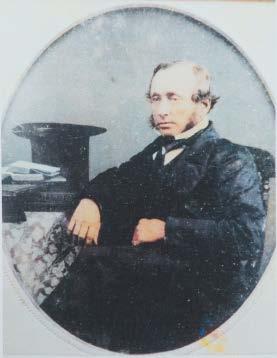
Captain Thomas Stuart R.N. (1797-1885) was born in Limerick, Ireland and entered the Royal Navy in December 1811. During the Syria campaign, he was the Senior Lieutenant aboard Hazard and was promoted to Commander on 4 November 1840 for his gallant conduct during the bombardments in which he took part. Besides the two Lifesaving medals and two campaign medals he earned during his career, Stuart was also in receipt of ‘..a valuable sword from Lloyds, for bringing in a vessel to Portsmouth from the Western Islands, which his ship had fallen in with in a sinking state.' That sword was earned whilst with Captain Austin in saving Hannah in 1829. The two previous silver medals from the Royal National Institute for the Preservation of Life from Shipwreck were 'For having put off in a boat & assisted to save the crew of 5 men of the sloop James which was wrecked in Cushendun Bay on the 3rd December 1834' and 'For having (unassisted) taken 3 men off a wreck among breakers to which no boat could venture. Ballymacaw Co. Waterford. 10 January 1838.' He married Lucy Bland, the daughter of Commander Bland, of Derryquin Castle, where he took his seat upon his return from the Mediterranean. The Captain died in Cork in 1885.
4

5
The box height: 4 in (10cm) Width: 7½ in (18.9cm) square
A
rare model of the 1833 Tyne lifeboat made by Thomas Young in 1898
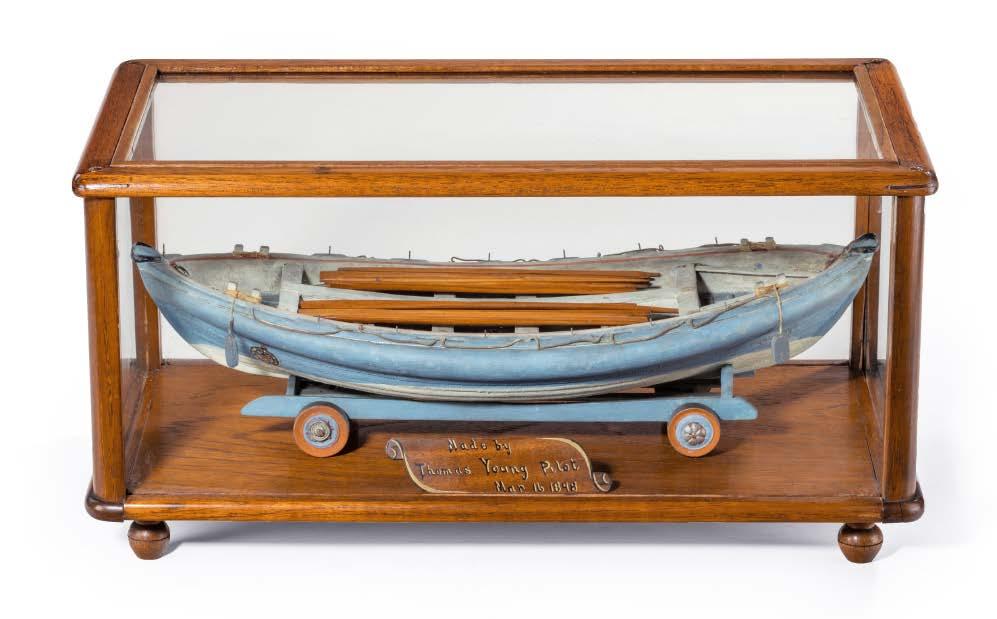
This historically interesting model is of the original Tyne lifeboat built in 1833. It has a simulated clinker hull with five thwarts, a bosun’s recess, carved wooden oars and is painted in blue and grey. It is mounted on a carriage with a plate inscribed ‘Made by Thomas Young, Pilot, March 16th 1898’ . In a glazed oak case. English, 1898.
Footnote: For a contemporary full hull model of the lifeboat Tyne built circa 1833 see the National Maritime Museum, Greenwich, London, Object SLR0747. Their
description reads as follows: “The double-ended hull is constructed plank on frame, in clinker fashion, and is complete with small decks bow and stern, which provide watertight compartments for added buoyancy. It is pulled by 14 oars and steered by a large oar over the quarter at either end. Internally, there is a deck grating covering relieving tubes, which allows the removal of water should the lifeboat become swamped. For added buoyancy and protection, a layer of cork is fixed just below the gunwale at either end on which is inscribed ‘Tyne Lifeboat’”.
6
Case height: 9½ in (24cm) Length: 18 in (46cm) Depth: 10 in (25.5cm)

7
Captain
Thomas Green’s silver Medals for Heroic Conduct at Sea dated 1837 and 1838

Medal diameter: 2½ in (6cm)
Height overall: 5¼ in (13cm)
One medal (far right) from Captain Logan of the Mars is inscribed ‘Presented by Captn. John Logan, of the Ship Mars that was Wrecked in a gale on the Gunfleet Sands, Jany. 12th 1837. To Captn. Thos. Wm. Green, for his heroic conduct in being the first Man to Jump overboard and haul the boat over the sand thus saving Captn. Logan and ten of his crew’ . The reverse has a fine repoussé scene of a three masted barque rolling in heavy seas, all within a fine twisted rope border. It is suspended from a white ribbon with blue edges and two silver bars inscribed ‘May God protect You’ - ‘In every Storm’ . Assay marks for George Adams (Chawner & Co), London, 1838.
The other (near right) is from Captain John Davis of the Don Ve Gan Castle stating ‘Presented by Captn. John Davis formerly Chief Mate of the Don Ve Gan Castle, of Exeter. April 26th, 1838. To Captain Thomas Wm. Green for his Heroic Conduct & Daring Spirit in a Gale of Wind
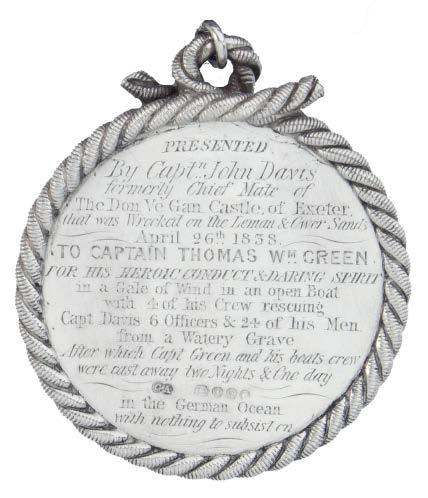
Medal diameter: 2½ in (6cm)
Height overall: 9 in (30cm) and 6 in (15cm)
in an Open Boat with 4 of his Crew rescuing Capt. Davis 6 Officers and 24 of his Men from a Watery Grave after which Capt. Green and his boats crew were cast away two nights and one day in the German Ocean with nothing to subsist on’ . The reverse has a fine repoussé representation of a 3 masted barque in choppy seas foundering against a cliff wall, all within a thick twisted rope border. It is suspended from a frayed blue and white ribbon and pin with three silver bars saying ‘Captain Davis's’ – ‘Gratitude’ – ‘To Captn. Green’ . Assay marks for London, 1858. These medals are interesting because they were both privately struck by grateful survivors as Green was not a lifeboatman per se. That from Captain Davis is particularly intriguing as it was presented 20 years after the rescue, possibly because, as Chief Mate at the time, Davis may not have accrued the funds for such a handsome piece until he had attained the rank of Captain.
8
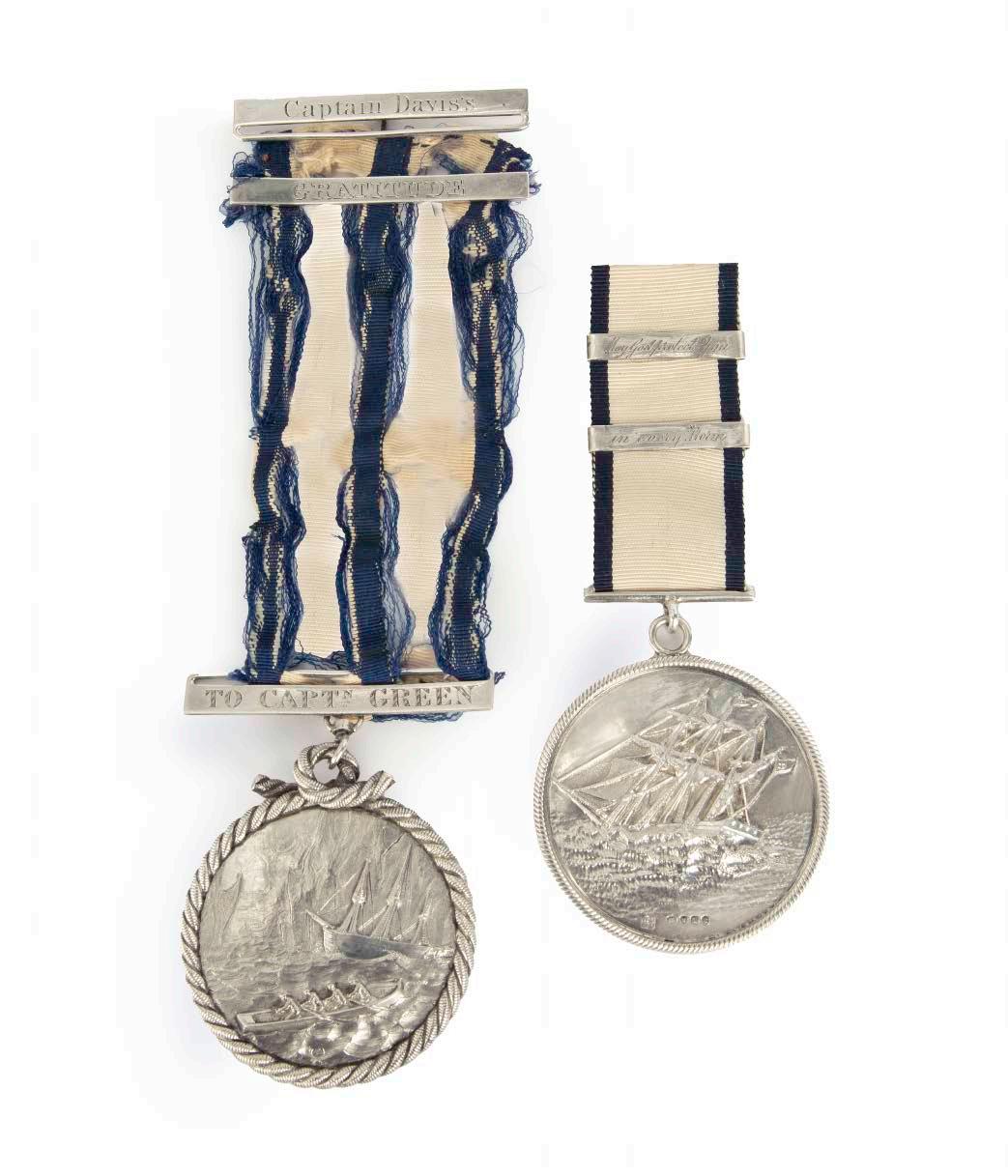
9
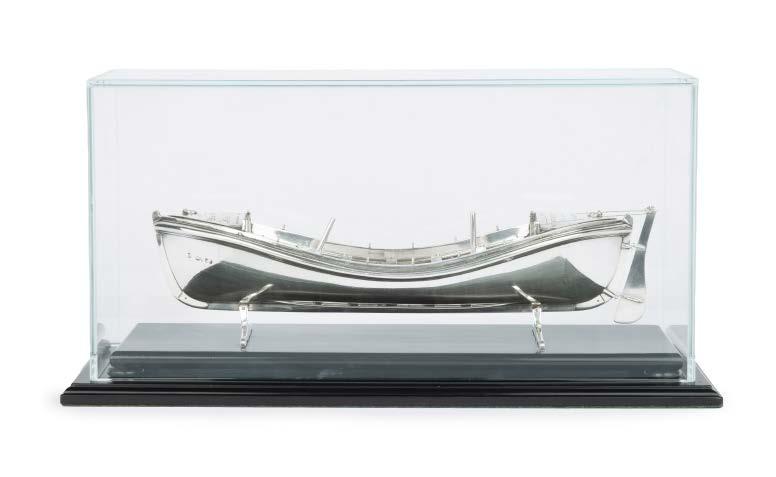
Model length: 13½ in (34.5cm) Case height: 8½ in (22cm) Width: 16½ in (42cm) Depth: 7½ in (19cm)
This solid silver inkstand is presented as a model of the Beeching-Peake SR (self-righting) Lifeboat. It has seven seats, plus flotation and storage lockers fore and aft which, having hinged covers and glass liners, act as inkwells. The covers are incised ‘Presented by the Duke of Northumberland to Isaac Watts Esq. assistant surveyor of the Navy’ and ‘For his valuable assistance in establishing Life Boats; 1852’. The hull is pinned to two silver supports which in turn rest on a wooden base. The masts and rudder are replaced, all within a glazed case. English, 1852.
In 1851 Algernon Percy, 4th Duke of Northumberland was persuaded to become president of the ‘Royal National Institution for the Preservation of Life from Shipwreck’. At the time the Institution was in dire financial straits. This, and the South Shields lifeboat disaster of 1849, in which 20 of the 24 Tyne’s river pilots were lost, determined the new president to sort things out. The Duke personally offered £100 to be won for the best design and model of a safe lifeboat, with a further £100 to finance her build.
He put together a committee led by Baldwin W Walker, Surveyor of the Navy, with Isaac Watts, Assistant Surveyor, John Fincham, Master Shipwright of HM Dockyard Portsmouth and James Peake, Assistant-Master Shipwright
of HM Dockyard Woolwich, Captain John Washington and Commander Arthur Jerningham. They had to make a selection from over 280 designs, several from outside the UK. They rated safety features on a points system in which ‘great designs for fenders, lifelines,’ etc earned 1 point, while 20 points went to ‘qualities as a rowing boat in all weathers’. The winning design with 84 points was submitted by James Beeching of Great Yarmouth. This design, with a few improvements by James Peake, became the RNLI’s standard lifeboat for over 40 years.

10
The Duke of Northumberland’s silver Lifeboat by Garrard & Co, 1852
James Beechings Prize Lifeboat (1851) (Wikimedia Commons)
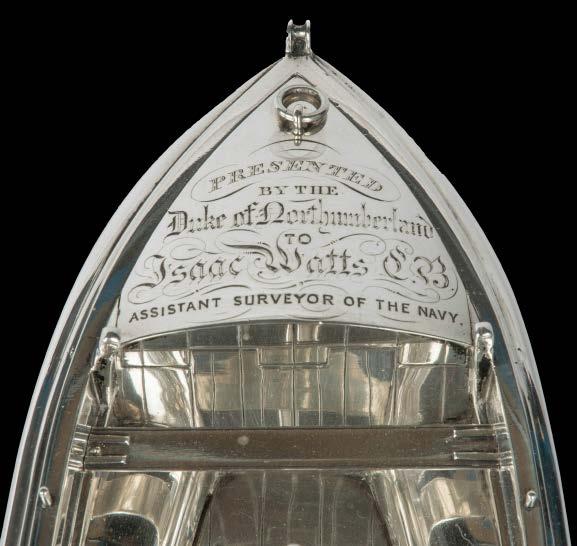
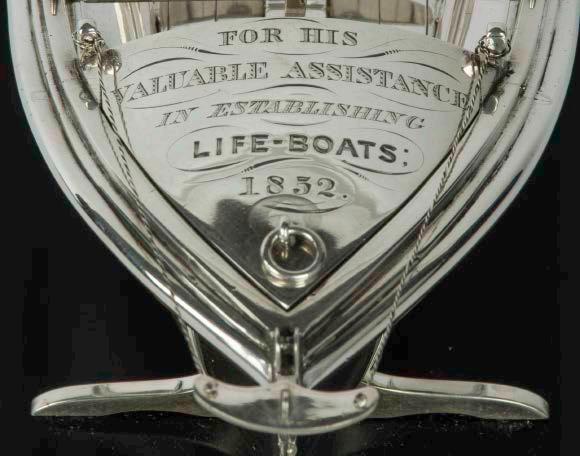
11

Framed height: 22 in (56cm) Width: 30 in (72cm)
This dramatic watercolour shows only the bow and the stern of Amelia as she is perilously close to being dashed against the sea wall with a wave completely swamping her amidships. Some of her crew have been washed out of the boat and would-be rescuers are wading along the promenade towards her bow. To her right, the schooner Coupland is rolling dangerously in huge waves. Scarborough Spa and crowds of onlookers are clearly visible through the storm. Signed J.N.Carter, 1865, Torquay . English, painted in 1865.
The attempted rescue of the schooner Coupland by the lifeboat Amelia on November 2nd 1861 is one of the most memorable and tragic in Scarborough lifeboat history. The 32 ft. long, ten-oared, self-righting Amelia , on her maiden voyage, went to the rescue of the Coupland crew, with disastrous results. She was dashed to pieces against the harbour wall and two of the crew were lost, while others had to swim or be pulled ashore by rescuers wielding ropes. Three of the shore based rescuers, Lord Charles Beauclerk, William Tindall and
John Hiles, also lost their lives. Eight Board of Trade Medals for Gallantry in Saving Life at Sea were awarded along with six RNLI medals and monetary grants.
Joseph Newington Carter (1835-1871) was influenced by W. M. Turner and is known predominantly for his dramatic and compelling seascapes in oil and watercolour. His father, Henry Barlow Carter, was a seascape painter who exhibited several times at the Royal Academy and ran a drawing school in Scarborough. Henry Vandyke Carter, Joseph’s elder brother, illustrated editions of ‘Gray’s Anatomy’ . Joseph was a pupil of and exhibited at the Royal Academy where his reputation was considerably enhanced when the Prince of Wales purchased two of his marine landscapes. He joined his family when they moved to Torquay in 1862, five years after the death of his mother, but his promising career was cut short when he died aged 36. It is well documented that his sister added ‘Torquay’ to his paintings posthumously, probably to emphasise the rise in the family’s fortunes and status.
12
Joseph Newington Carter: The loss of the Scarborough Lifeboat Amelia, 1865

A Lugger lifeboat model by Twyman for the International Exhibition, London 1862
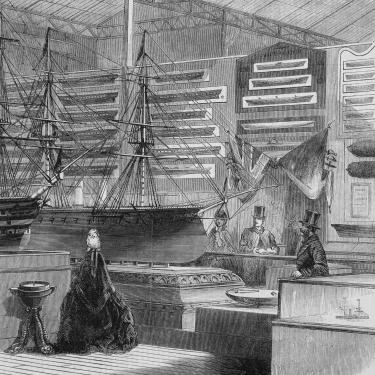

The planked and pinned hull of this lifeboat has a lead keel, bilge keels, a wooden rudder with a yoke, gessocoated canvas wales and a grab line. It is fitted internally with a forward compartment enclosing a stove and glazed deck lights, seats, covered hatches with copper strapping, a bilge pump with a handle, mast securing points, a metal anchor with a buoy and other details, together with a quantity of furled masts and rigging, a silk flag, and other accessories. The bow has ‘Sunbeam/Friend of all Nations’ and the stern has ‘Ramsgate’ , painted in gold on a black ground. In a glazed case on a mahogany stand. English, 1862.
Provenance: H. Twyman (designer/modeller) thence by descent
Exhibited: International Exhibition, London 1862, Vol. 2, object no. 2760
The 1862 International Exhibition in London hosted a fine array of exhibits from 28,000 exhibitors, and enjoyed a footfall of 6.1 million (about the same as that of the
1851 Great Exhibition) but yielded a cleared profit of just £780. As Paxton's innovative 'Crystal Palace' had been removed to the suburbs, the 1862 exhibition was housed on the site of what is now the Natural History Museum. According to the catalogue The National Lifeboat Institution exhibited some interesting models of boats for improving this humane branch of the naval service, and indeed, lists a number of lifeboat models, many with extraordinary claims for being indestructible or unsinkable. This lifeboat was designed by Twyman to have "air-tight compartments" sealed within the structure. These, combined with scupper pipes running through the floor the length of the craft, must have meant it was nearly always swamped with water. It would have been a costly alternative to the simpler cork-ended sailing and pulling type selected and used successfully for several decades. The quality of the model provides a tantalising glimpse at what would have been a very interesting stand, as shown in the illustration above of The Admiralty Department of the Naval Court.
14
Credit: The Illustrated London News
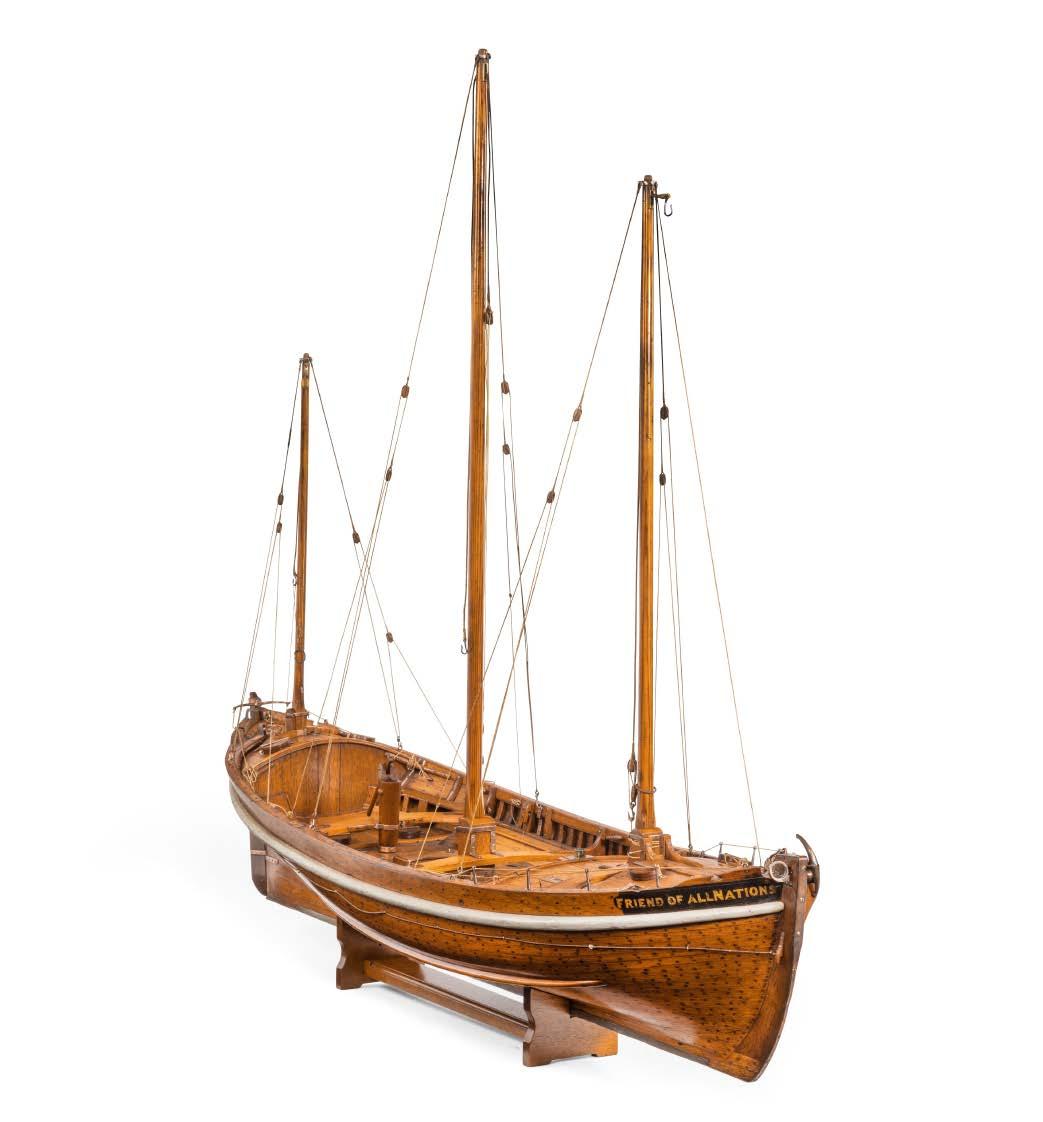
Case height: 48 in (122cm)
Width: 50½ in (128cm)
Depth: 20¼ in (51.5cm)
Overall height: 76 in (193cm)
15
A very fine model of the first Flamborough lifeboat, St Michael’s Paddington, 1871

This highly accurate model has an oval silver plaque incised ‘Model of the S. Michael’s Paddington Lifeboat, Stationed at Flamborough, under the management of the Royal National Lifeboat Institution, this model was presented by the Institution to the Revd. G. F. Prescott, MA, 1871’ . For a fuller description of this model please see page 18.
The first lifeboat to arrive at Flamborough's number two station at South Landing was the "St. Michael's Paddington" . She was 33 feet long, had an 8 foot 6 inch beam and cost the princely sum of £278, which was met by the parishioners of St. Michael's Church, Paddington. Their efforts, guided by the vicar, the reverend G. F. Prescott M.A., raised £640 as their aim was not only to provide a lifeboat but also a lifeboat station on Flamborough Head. The lifeboat's crew of thirteen was made up of a Coxswain, Second Coxswain, bowman and ten oarsmen. Carriages for the boat could not be employed because the beach was uneven and rocky so an additional ten to twenty men formed the launching party. It was their job to manhandle the boat from the boathouse, down the slipway, across the beach and into
height: 11 ¼ in (29cm) Width: 33 in (84cm) Depth: 12 in (30cm)
the water. The reverse was carried out when recovering the lifeboat. She stayed on station for thirty years and saved 8 lives. This class of lifeboat came from a design by Mr. James Peake. We are indebted to Simon Robson ©1998-2007 Helmsman - Flamborough Lifeboat Station for his fascinating research.
Literature and Exhibitions: Known examples of selfrighting pulling and sailing lifeboats can be found in the National Maritime Museum with the following footnote: ‘These models were produced for publicity purposes or given as a token of thanks to individuals who donated money for the purchase of a lifeboat. From 1860 to 1915, this class of lifeboat ranged from twenty-eight feet to forty feet in length and formed the backbone of the RNLI fleet. They were manned by volunteers and stationed all over the UK as well as being adopted by lifesaving institutions abroad. They were moored afloat or could be launched from a boathouse down a slipway, or off of a horse drawn trailer directly into the surf.’ The RNLI owns Clovelly’s Alexander and Matilda and Rhyl’s Morgan , among others.
16
Cased
Peake self-righting lifeboats: This class of lifeboat was totally open to the elements. They were constructed from two half inch thicknesses of mahogany. These were laid diagonally and opposing with copper rivets fastening them together, which meant the boats were natural self-righters. The original, built at Woolwich Dockyard under sponsorship from the Government, was 30’ long and had an extreme breadth of 7’6”. There were cork-wrapped air cases under the seats and in the bow and stern and a 7cwt keel. In addition, six tubes passed through the hull which could clear a boat full of excess water in 30 seconds. The boat showed tremendous stability and buoyancy when coming ashore through dumping surf without shipping any water.

The need for better lifeboats was highlighted in the following extract from ‘The Engineer’ magazine “During the year 1854 our coasts were the scene of no fewer than 987 wrecks of ships …. there are believed to have been the fearful number of 1,549 human lives lost by these catastrophesand all, be it remembered, on our own coasts - on the coasts of the busiest maritime island in the world: when, if there be liability of disaster through the vast congregation of shipping, there ought on the other hand to be a supply of invention and good sense sufficient to check, in same degree, such disasters.” The Engineer went on to state that, despite these calamities, 132 people were saved by the RNLI in 1854. Twenty to thirty of Peake’s boats were built and the RNLI ‘adopted them to the exclusion of others built from different designs.’

17
Testing a self-righting lifeboat. Charles Joseph Staniland. Credit: Wikicommons
A lifeboat's self-righting power is tested by tipping it over with a crane at the Royal National Lifeboat Institution's store yard beside the Limehouse Cut c.1885. Illustrations for "Lifeboats and Lifeboat-men" by C F Staniland in the English Illustrated Magazine of February and March 1886 Public domain. Charles Joseph Staniland
A

This model is very similar to the one on the previous pages. The 20-inch hull is carved and painted in blue and white with grab ropes attached to the red gunwales and has the RNLI logo painted on the bow and rudder. The detailed fittings include slatted bench side seats, footplates, thwarts, brass scuppers, a yoke tiller and both blue and white painted oars. The number 140 is painted within the life ring fixed to the bow. The mast and boom are unstepped and folded onto the seats with a furled

sail and other details. A silver presentation plate is inscribed ‘Model of the “Huddersfield” Lifeboat, Stationed at Hasborough, under the management of the Royal National Lifeboat Institution, this model was presented by the Institution to J. Thomas Kilner Esq., 1888’ . It is in the original glazed wooden case, with accompanying paperwork.

18
presentation model of the Hasborough/Happisburgh Lifeboat, Huddersfield 1888
Cased height: 10½ in (26.5cm) Width: 32 in (81cm) Depth: 12 in (30.5cm)
Credit: Happisburgh Lifeboat
Provenance: Thomas Kilner and thence by descent. Huddersfield No. 140 was donated by the town of Huddersfield and built by Forrest & Son. It was a self-righting lifeboat, length 34’ 1½” beam 7’ 6”, with two standing lugs, a jib and 10 oars. She went to Hasborough in 1887 and was withdrawn in 1906 unfit for sea service, but continued her service as a demonstration vessel until 1920.
Mr Kilner was the Honorary Secretary of the Huddersfield branch 1884-1894. Between him and his predecessor, Mr J. Harrison, voluntary contributions were sufficient to supply £700 towards this lifeboat. Considering the donations for 1872 were a mere £8, the accompanying paperwork is accurate in its description of him as ‘the Energetic Honorary Secretary’

19
Thomas Rose Miles: Hastings Launch, A signal of distress in the Offing

This oil on canvas shows oilskin-clad fishermen attempting to launch the Hastings lifeboat off the beach through heavy rollers. The boat, numbered RX.21 , is presumably going to investigate a tiny distress flare gleaming amongst deep grey storm clouds on the far horizon. There is the vague outline of a stricken square rigged sailing vessel in the gloom. Signed in red ‘ T. R. Miles’ . The reverse inscribed ‘Hastings Beach, A signal of distress in the Offing’ . English, circa 1890.
Provenance: Cmdr. Michael Wallrock R.N. Private collection and thence by descent.
Thomas Rose Miles RCA (1869-1910) was an artist who painted many landscape and marine scenes, working in both oil and watercolour. His nautical works aimed
to capture the bravery of man battling against the overwhelming power of the sea. Works frequently included rescue boats and vessels in difficulty, with typical titles including ‘Launch of the Life Boat’, ‘Storm Driven off Scarborough’ and ‘Fishing Boat in Distress’ . Miles found popularity among coastal communities since it was their struggles and valour that inspired him. See pages 82-83 for a model of a Hastings Lugger.
Miles exhibited with the Royal Academy, the Society of British Artists, the Royal Society of British Artists, the Royal Hibernian Society and Arthur Tooth and Sons Gallery in London. His works can be found in public collections in Bristol, East Ayrshire, the Isle of Man, the Isle of Wight and Sunderland, among others.
20
Framed height: 30½ in (77.5cm) Width: 48½ in (123cm)


21
Thomas Bush Hardy: In distress off Staithes, York, 1896

This watercolour on paper is signed, inscribed and dated. It shows crowds of people on the steps and harbour walls of the coastal town of Staithes watching a fully crewed lifeboat pulling towards a stricken sailing ship. Waves throw spray up onto a jetty in the foreground while the towering white cliffs loom in the distance. The reverse has a paper label for Frost & Reed, Bristol and Clifton, Picture Frame Makers, Artists’ Colourmen & Print Sellers and Picture Dealers, established 1808. The original gilt frame is inscribed ‘In Distress - Off StaithesYorks T.B.H. - 1896’ . English.
There has been an RNLI lifeboat stationed at either Staithes or Runswick since 1866, and for many years
there was a lifeboat in both villages simultaneously until the decision was made in 1938 to rely on Runswick alone due to a lack of manpower. At the time of this painting, Staithes had a 34 foot self-righting boat called Jonathan Stott (1894-1904).
Thomas Bush Hardy (1842-1897) was born in Sheffield, Yorkshire. He was one of the most successful and prolific artists in an era when English marine painting in watercolour reached its zenith. Elected into the Royal Society of British Artists in 1884, he exhibited with them and also at the Royal Academy, predominantly showing coastal scenes in England, the Netherlands, the French Channel ports and the Venetian Lagoon.
22
Framed height: 8½ in (22cm) Width: 27½ in (70cm)
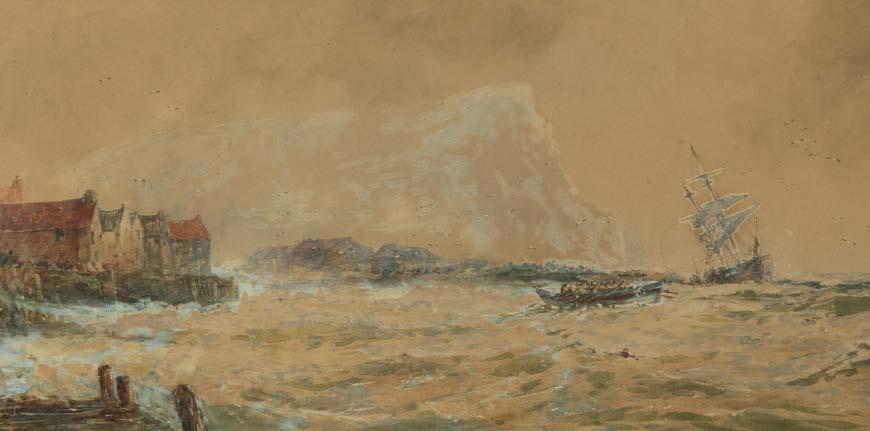
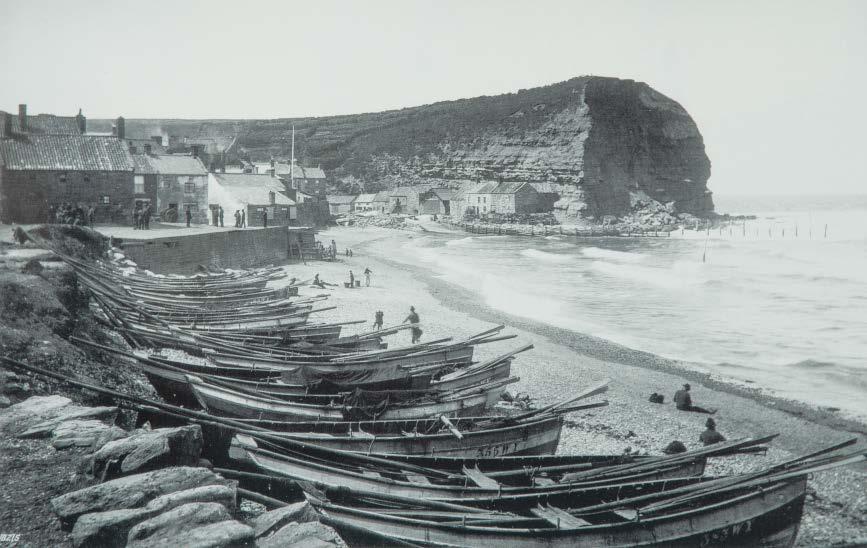
23
A photograph of the fishing village of Staithes in the 1880s by Francis Frith.
Sir Harold Dudley Clayton's Hydraulic Steam Lifeboat: City of Glasgow, 1894

This fine builder’s presentation scale model has a gilt brass funnel, polished brass rudder, capstan, anchor, binnacle and fittings with side grab ropes. The hull is painted in RNLI blue and red, with a pink keel. It is raised on a turned brass support within an ebonised glazed case on a stand and has a presentation plaque inscribed 'Hydraulic Steam Lifeboat City of Glasgow' Built For the Royal National Lifeboat Institution, by R & H Green, Blackwall Yard, London, 1894' .
Provenance: Sir Harold Dudley Clayton. The following pages are dedicated to the substantial and fascinating archive of Sir Harold Dudley Clayton. This includes the lifeboat model above, over 100 yacht designs and naval architects’ drawings, photograph albums, photographic glass slides and a model of his yacht Coquette . Steam-powered lifeboats. Earlier in the 19th century steam had transformed Britain’s industrial landscape through the development of steamships and the
railways. But tending a coal-fired boiler in a boat that is pitching and rolling in heavy seas would not have been straightforward. Sixty years after the idea was first mooted by Sir William Hillary and after extensive trials, the first steam-cum-sail boat Duke of Northumberland went into service at Harwich Lifeboat Station in September 1890. The hydraulic steam-driven lifeboat used waterjets instead of propellers. This advance in technology would replace the rowing boats used by the RNLI and marked the beginnings of modernisation across the lifeboat fleet. Only five steam lifeboats were ever built. Two of these, City of Glasgow and Queen , used waterjets; the other three, City of Glasgow II, James Stevens No. 3 and James Stevens No. 4 were propellerdriven. Between them, the three hydraulic steam-driven lifeboats were in service for over 40 years and saved 570 lives. A similar model of the City of Glasgow is held in the Science Museum. London.
24
Case height: 15¼ in (39.5cm) Width: 48¾ in (124cm) Depth: 18½ in (47cm)


25
City of Glasgow in Harwich, courtesy of University of St Andrews Libraries and Museums.
Leather case height: 5½ in (14cm)
Width: 14 in (36cm)
Depth: 9 in (23cm)

This extensive and fascinating archive comprises many different sections largely devoted to shipbuilding in Penarth in the late 19th and early 20th centuries. There is a collection of late 19th century ¾ plate glass negatives of boats and regattas etc., many in their original developing envelopes with dates, locations, exposures and comments, subjects include; 'Naval Review, Spithead 1897', 'Henley Regatta, 1897', 'Diamond Jubilee Procession, 1897', 'St Ives Harbour, 1896', '19001909 Penarth... Photos of boats built', ‘Swansea Regatta, 1895' and related subjects, together in a black leather case with initials F.T.A.C. In addition, there are four red cardboard holders and an indexed fitted box of early 20th century ½ plate negatives of 'Penarth Yacht & Boat Building Co & Ship Repairers' comprising images of the construction of the workshop next to Penarth Lifeboat station and numerous stages in the building, fitting out and launching of various craft. There are also five black and white photographs of the Filey lifeboat 'Hollon the Third' (in use 1907-1937) being hauled ashore by a team of horses. English, circa 1900.
Sir Harold was the 10th Baronet of Clayton, Marden (1877-1951), whose roles included Lieutenant of the Severn Division of Submarine Miners, Commodore of Penarth Yacht Club, RNLI Committee member and chairman of the Torbay branch of the Institution. As a boat designer and builder, he opened a yard on the site near the Charles Cooper boatyard on the shingle beneath Penarth Head, south of the Marine Hotel.
Penarth Yacht Club was established in 1880 in a substantial stone boathouse, built by the RNLI in 1861 for £118. It remained in use until it was sold to Lord Windsor in 1884, and demolished to make way for the Esplanade. Early club sailing boats were a mixed class of small craft and sloops. However, these boats could not withstand the winter weather experienced at the moorings off the Club and, after a series of mishaps, a class that could be hauled up into the boathouse was adopted. Over the next 30 years, former Commodore Harold Clayton, designed and built The Mosquito class (1901), the 12 Foot Dinghy class (1908) and the Seabird Class (1920). He raced his own 12 Foot dinghy Myosotis (Forget-me-not).
26
The Sir Harold Dudley Clayton photographic archive: Penarth
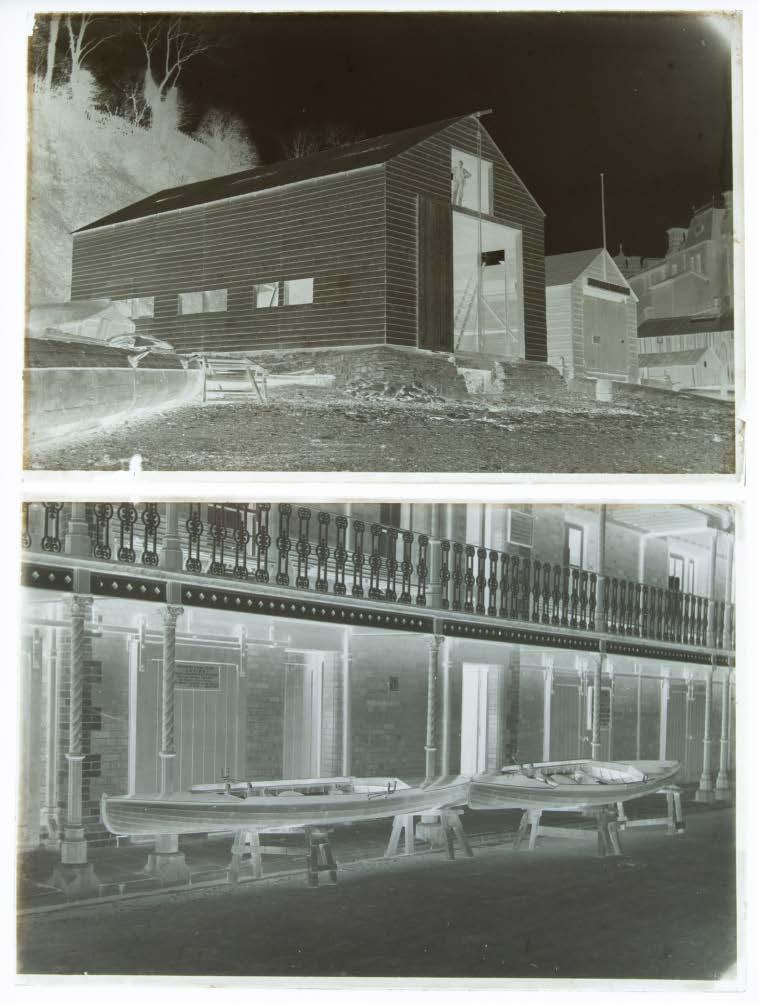
27
Above: Construction of Penarth Yacht & Boat Building Co. beside Penarth Lifeboat Station circa 1900.
Below: The Penarth Yacht Club.
The Sir Harold Dudley Clayton photographic archive: RNLI

There are two early 20th century photograph albums (1901-1905 and 1908-1911) containing annotated images including, 'At Work with the Submarine Miners Severn Division Royal Engineer Volunteers, 1901', 'Barry Dock, Glam', 'Cowes 1905', ‘Penarth Yacht Club’, ‘Minehead’, ‘Ilfracombe’, 'Wreck of the Mabel' (his father’s yacht), 'Watermouse, 1909', 'Clovelly', 'Dartmouth', and ‘Fowey Regatta'. There is also a copy of 'The Life-Boat and its Work' by Sir John Cameron Lamb, with a personalised dedication to Sir FitzRoy Clayton and a copy of the ‘The Lifeboat Centenary Number, 18241924’.
Penarth Lifeboat station was built in 1861 at the foot of the cliff below the Coast Guard station for £118. In 1905 the station was closed and sold for £10. Sir Harold was brought up to serve the RNLI as his father was a key member. The obituary of Lieutenant Colonel Sir FitzRoy Augustus Talbot (1834-1913) states that ‘he was himself intimately associated with the work of the Royal National LifeBoat Institution for half a century. While still on the Active List he joined the Committee of Management in 1863, was elected Deputy-Chairman in 1883, Vice-President in 1885 and Chairman in 1908’ until taken ill in 1911. On his retirement from the Chairmanship, the new Motor Lifeboat for Newhaven was named Sir FitzRoy Clayton as a tribute to his great services to the Lifeboat cause. On his death, the King's Private Secretary wrote, "The King was very sorry to hear of the death of Sir FitzRoy Clayton, and desires me to express his true sympathy with you in your sorrow. His Majesty has known your father for many years, and was especially associated with him in the work of the Royal National Life-Boat Institution to which Sir FitzRoy devoted himself for so many years."
The cover of the ‘Centenary Number’ of The Lifeboat Magazine, shown above, featured a giant lifeboat man holding a sailing/rowing lifeboat dated 1824 in his right hand and a motor lifeboat dated 1924 in his left to show the advances in lifeboat efficiency over the 100 years since the creation of the RNLI.
A lifeboat station was first established at Filey in 1804. In the late spring of 1860, a hurricane hit Filey and destroyed all the boats and nets of the local fishermen. As the damaged items belonged mostly to the men who manned the lifeboat, an appeal was made in The Times to aid in the support of the fishermen's loss of livelihood. One of the letters written to the paper was by a local resident doctor who noted that the Filey Lifeboat (up until that point) had saved more lives at sea than any other station belonging to the RNLI in England.
28
Largest album height: 9¾ in (25cm) Depth: 12 in (30cm)



29
Three pages of photographs featuring Penarth Y.C. and the Watchet Lifeboat.
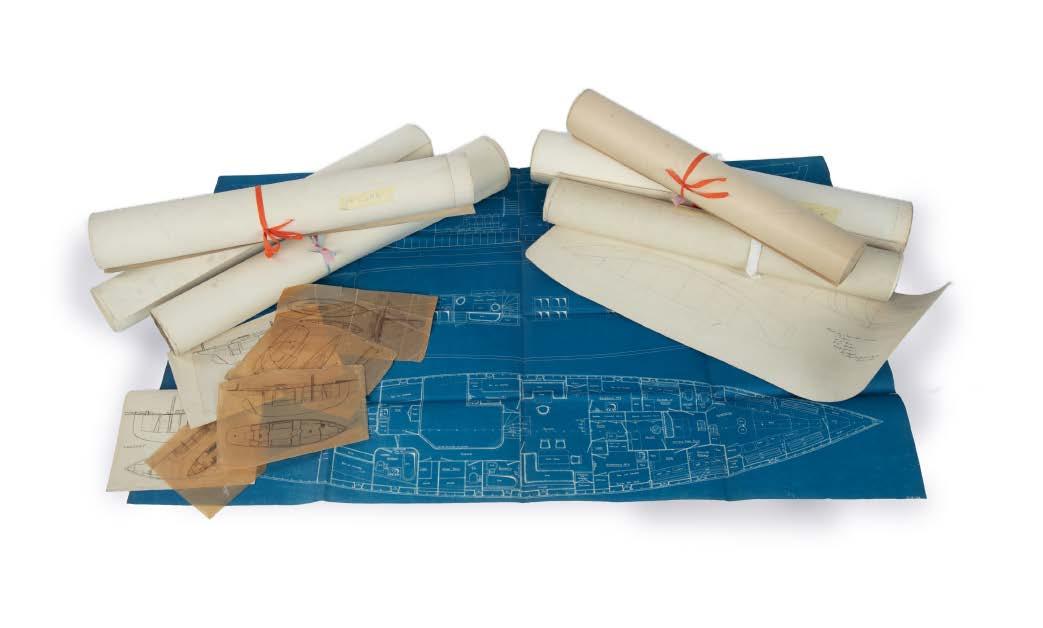
Blueprint height: 24 in (61cm) Width: 41 in (104cm)
This marine architect’s plan for a new lifeboat for Newhaven by G.L. Watson & Co., 1915 is inscribed ‘38ft 9ft 9in Motor Lifeboat for “Newhaven”, Sections in Way of Aft Endbox & No.5 Station Scale 1in to 1foot’ and stamped: ‘G.L.Watson & Co, Naval Architects & Surveyors, No.14 Glasgow. 24th May 1913’. The accompanying blueprint is headed ‘Proposed Hydraulic Life-Boat, For the Service of the Royal National Life-Boat Institution, Scale ½“- 1 Foot’. Scottish, 1913.
Provenance: Sir Harold Dudley Clayton from G.L.Watson
It is quite possible Sir Harold ordered these particular designs from G.L. Watson because he knew that the new motor lifeboat for Newhaven was to be named Sir FitzRoy Clayton as a tribute to his father. (See previous pages.)
The first lifeboat paid for by local subscriptions was placed at Newhaven in 1803. She was moved to Brighton in
1809. Then the Institution provided a boat in 1825, which in turn was sent to Cowes in 1829. The Shipwrecked Fishermen and Mariners’ Royal Benevolent Society reopened the station in 1852 and it was finally taken over by the RNLI in 1854. In 1904 the prototype motor-driven lifeboat, ON343, was sent to Newhaven for water trials.
In 1887 the famous yacht designer G.L. Watson became chief consulting Naval Architect to the RNLI, a position which his company would fulfil through to the late 1960s. He worked extensively for the RNLI with his boats becoming renowned for their seaworthiness and durability. Over the next 55 years, 171 boats of the various Watsonclasses were built. They ranged between a 40 ft Watson (1908) and a 47 ft Watson (1963) in 8 separate classes.
(See pages 36-37 for a model of a Watson 41ft Class Lifeboat.)
30
The Sir Harold Dudley Clayton archive: G L Watson Lifeboat plans, 1913
Sir Harold Dudley Clayton: Naval architect and boat builder’s plans

A further component of the collection is over 100 early 20th century naval architect and boat builder plans, blueprints and tracings. The majority is signed and dated 'Harold Clayton' and 'Penarth' , various vessels including, 'Cabin Plan 130TM Aux Ketch for Peter Hoare Esq Luscombe Castle', 'Sketch for 12 ton Yawl. Designed for Capt. R McNeil', 'Jumbo. 2nd Prize Yachtsman 1898',
'Valkyrie III sail plan', 'Shearwater. Designed for Mr J J Neale', 'Neried', 'Modweina', 'One Design Class. Designed For Club Maritimo del Abra' (Biscay), Myosotis, Penarth Dinghy Class' (his own boat), 'Arghiro RYS The Right Hon Lord Churston' and other, on drawing paper and wax paper, various sizes. English, circa 1900.
Provenance: Sir Harold Dudley Clayton
31
The largest height: 47 in (120cm) Width: 29 in (74cm)
32
Sir Harold Dudley Clayton: Naval architect and boat builder’s plans for Zinita, 1909

Four framed naval architect’s drawings of the sail plan, cabin plan, sections and hull of ‘Zinita, 30 tons’ , signed ‘Harold Clayton, Penarth, June 1909’ . There is also a plan for a ‘Motor Dinghy for Zinita, 30 ton, L.O.A., 13’ 0”’, Beam 4’7”, 1913’ . Each one is signed.
Provenance: Sir Harold Dudley Clayton
 Cabin plan height: 26 in (65cm) Width: 40 in (101.5cm)
Cabin plan height: 26 in (65cm) Width: 40 in (101.5cm)

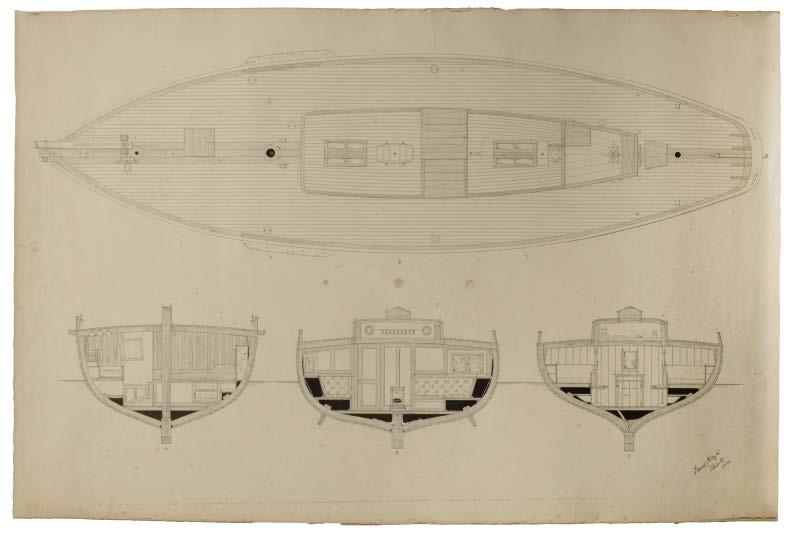
33
Sir Harold Dudley Clayton’s scale model of Coquette, 1899
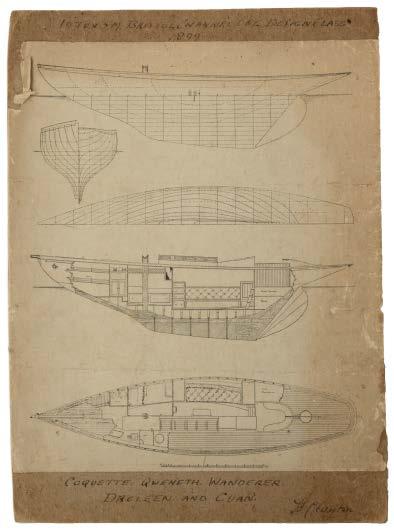
Model height: 48 in (122cm) Width: 42 in (107cm)
Overall height on stand: 95 in (241cm)
This large model is of the 1/12th scale 10-ton Bristol Channel One Design class Coquette: She is fully rigged with furled sails over a simulated planked deck complete with fixtures and fittings. The hull is painted black to the waterline and copper coloured beneath. The whole is raised on a wooden stand and enclosed in a glazed display case which in turn rests on a later mahogany stand with a brass plaque stating “‘Coquette'. 10 tons. 1900-1906. Designed, built and owned by Harold Clayton. L.O.A. 35'-0'', L.W.L. 26'-0'', Beam 8'-9''. Draft 6'-0''. Disptnt. 8.5 tons. Sail Area 834''. 10 Firsts 3 Seconds in 13 starts & in cruising about 12,000 miles. Scale 1 inch to 1 foot.’ Together with a line drawing titled ‘10 tons Bristol Channel Design Class, 1899’ with the names of the yachts Coquette, Qweneth, Wanderer, Droleen and Cuan listed below. English, 1899.

Provenance: Sir Harold Dudley Clayton
On Saturday 5th May 1900, The Field described her launch as follows ‘The first boat of the Bristol Channel one-design was launched last Saturday. The boats of this class are 10 tons measurement and have been built at the new yard of the Penarth Yacht and Boat Building Company. Before leaving the ways the new boat was named Coquette; she appears to be a fine, able, little sea boat. The interior arrangements are good, and the cabins very roomy for a vessel of the size; they are fitted in teak and canary wood panelling. The Bristol Channel one-design class are from lines by Mr Harold Clayton.’
34

35
A scale model of a 'Watson' class lifeboat, circa 1931

This 1.32 scale presentation model has a carved hull finished in white and blue with a red wale and RNLI pennant on the bow. The deck is painted blue-grey and fitted with grab rails, deck rails, bitts, a folding mast with navigation lights, a fitted cockpit and other details. It is mounted on four plated columns above a stepped wooden display base with a brass plate engraved ‘41ft Watson class motor lifeboat. Length 41ft, Beam 11ft8", Displmt 14.5t, crew 8, draught 3'8", twin screw, spd 7.5kts, blt 1931-52’ and in a later hinged plexiglass case.
The 41ft Watson-class was a non-self-righting displacement hull lifeboat built between 1931 and 1952 and operated by the Royal National Lifeboat Institution between 1931 and 1981. It was designed for service at stations that required a larger and more powerful boat than the standard carriage-launched types, but which could not accommodate the larger Watson types through boathouse or slipway constraints. In all 18 boats were completed. It had an aft cockpit with a cabin ahead of
it, containing the engine controls, and a separate forward shelter with room in the two for 16 people. The boats carried two sails as an auxiliary to the twin Weyburn AE6 6-cylinder petrol engines.

36
Case height: 11½in (29cm) Width: 21½in (54.5cm) Depth: 10in (25.5cm)

38 A working model of a motor lifeboat by
Bassett-Lowke
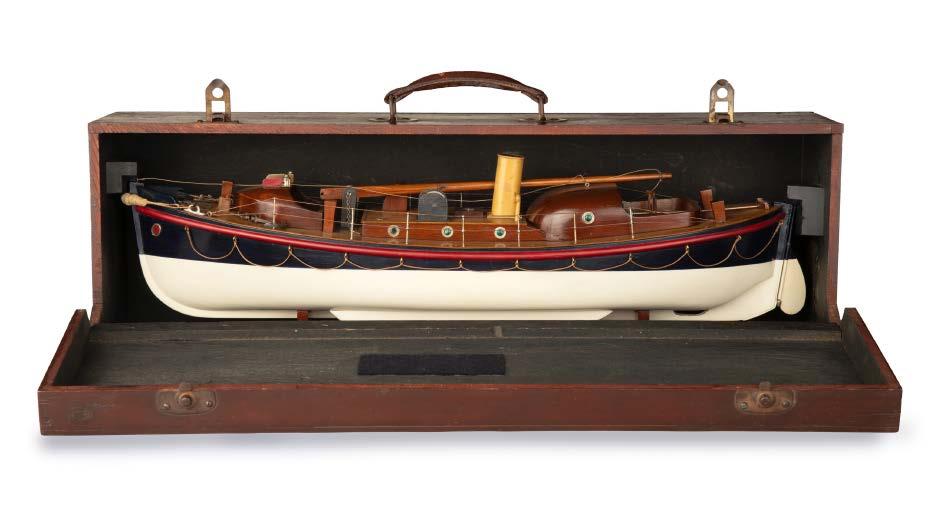
Height: 18 in (46cm) Length: 24 in (61cm) Case height: 9 in (23cm)
This intricate model has a wooden hull with lined boxwood decks, a folding mast, a yellow funnel and a nickel-plated steering wheel. The centre has a removable mid-section which opens to reveal the original electric motor. The lifeboat is set on a mahogany cradle and fits snugly into its original carrying case with the initials D. M. L. in black on the side. A plate in the bow states ‘Bassett-Lowke Ltd. Model Makers, Manchester-LondonEdinburgh’ . British, circa 1938.
Provenance: From the estate of Mr D.M. Lumsden and thence by direct descent.
26½ in (67.5cm) Depth: 7 in (18cm)
Wenman Joseph Bassett-Lowke (1877-1953) was born in Northampton and is noted for having founded the firm of Bassett-Lowke which specialised in producing construction sets, model railways, boats and ships. He was a friend and patron of the architect and designer Charles Rennie Mackintosh, stained glass maker E. W. Twining and German architect-designer Peter Behrens. He served as the executive of the Fabian Society from 1922 until 1924, where he was so impressed by George Bernard Shaw that he had him immortalized as a railway platform accessory. The original cost of this model in the 1983 catalogue was £7 7s.
Length:


39
Dominic Serres: HMS Formidable, St. Albans, Belliguard and Swift (Brig.) 1784

This oil painting on canvas shows four Royal Navy battleships sailing on various tacks, away from two large, jagged rocks in the middle of the ocean. The low sun on the horizon is turning the clouds gold and pink. A paper label for The Leger Galleries, 13 Old Bond St., W.1., carries a longer title ‘Dominque Serres: the Formidable, the St. Albans, Belliguard and Brig Swift, on the way back from the West Indies with Admiral Piget. Dominic Serres. RA. 15th June 1783’ . Signed and dated 1784. English.
Provenance: Alan Russett
Alan Russett (1929-2021) was educated at Bristol Grammar School and Exeter College, Oxford. Following a successful career in the international petroleum business, he joined the Friends of the National Maritime Museum as a researcher and archivist. This inspired him to write ‘George Chambers 1803-1840: The Sailor's Eye and the Artist's Hand’, ‘Dominic Serres R.A., 1719-1793, War Artist to the Navy’ and ‘John Thomas Serres 1759-1825: The Tireless Enterprise of a Marine Artist’.
40

41
Height: 13½ in (39.5cm) Width: 18½ in (47cm)
A relic from the family of Bounty Mutineer John Adams
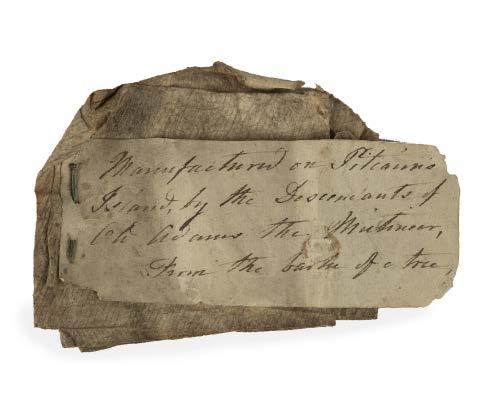
This small, documented piece of Barkcloth from the Pitcairn Islands is an exceptionally rare survivor from the notorious Mutiny on the Bounty . It has a fragment of paper pinned to it stating ‘Manufactured at Pitcairn’s Island, by the descendants of John Adams the Mutineer, from the bark of a tree.’ Pitcairn, circa 1830.
Provenance: Private collection, Hampshire
For similar examples see the collection of the British Museum (Oc1937,0308.1 and Oc1937,0308.2) each with the same handwriting as the example offered here, but signed ‘H. Porter’ and dated 1837 and another in the National Maritime Museum, Greenwich.
John Adams (1767-1829), also known as Alexander Smith, was the last survivor of the Bounty Mutineers who, in 1790, led by acting Lieutenant Fletcher Christian, seized control of the ship from their captain, Lieutenant William Bligh, and set him and eighteen loyalists adrift in the ship’s open launch. In an effort to find a safe hiding place, the
Approx height: 2 in (5cm)
Width: 3 in (7cm)
mutineers settled on Pitcairn and eventually established a Christian community there. The American sailing ship Topaz rediscovered Pitcairn in 1808, but by then Adams was the sole surviving mutineer and he was granted amnesty for his part in the mutiny. In 1825 Adams married Teio, or ‘Mary’, the mother of his son, George Adams. Adams’ grave on Pitcairn is the only known grave site of a Bounty mutineer and the main settlement and capital of Pitcairn, Adamstown, is named after him.

Barkcloth, or ahu in Tahitian, provided the principal material for clothing throughout the Society Islands, and could also be hung ornamentally, used as a partition or as bed sheets. Barkcloth was produced by women using strips peeled from the soft inner bark of breadfruit, paper mulberry and fig trees. These strips were then soaked for several days before being beaten together into a continuous sheet using wooden beaters. The finished sheet was left in the sun to bleach, and vegetable dyes could then be pressed into the cloth using leaves and other vegetation to create patterns.
42
Wikimedia
Commons John Adams (BM 1861,1109.519)

This small snuff box is carved in the form of a 112-gun ship of the line with a removable quarterdeck. The bow is naively carved with a female figurehead. The captain’s cabin in the stern has two large arched windows and ornate wooden struts with carved bands. It stands on two small splayed legs. French, circa 1800.
As England won naval victory after naval victory in the Napoleonic Wars, the ever increasing number of prisoners became a problem. Many were kept in floating hulks anchored in the harbours of Portsmouth, Plymouth and the Medway with 900 men to a ship. Others went
to prisons at Norman Cross in Huntingdonshire and Dartmoor. One of the most striking things about certain of these prisoners was that, though conditions were very rough, they managed to make beautiful objects from bone, wood and straw, which they were allowed to sell. They made playing cards, dominoes and dice, snuff boxes, trinket boxes, houses, miniature guns and gun carriages, models of the guillotine and the Spinning Jenny with moving figures. Perhaps the prisoners’ finest achievements were their beautiful model ships with accurate rigging, decks and guns. (See the following pages for a superb example of such a ship.)
43
carved boxwood prisoner of war battleship snuff box
A
Height of model: 2¼ in (6cm) Width: 6½ in Depth: 1½ in (4cm) Actual size.
A bone Napoleonic prisoner of war model of Creolian
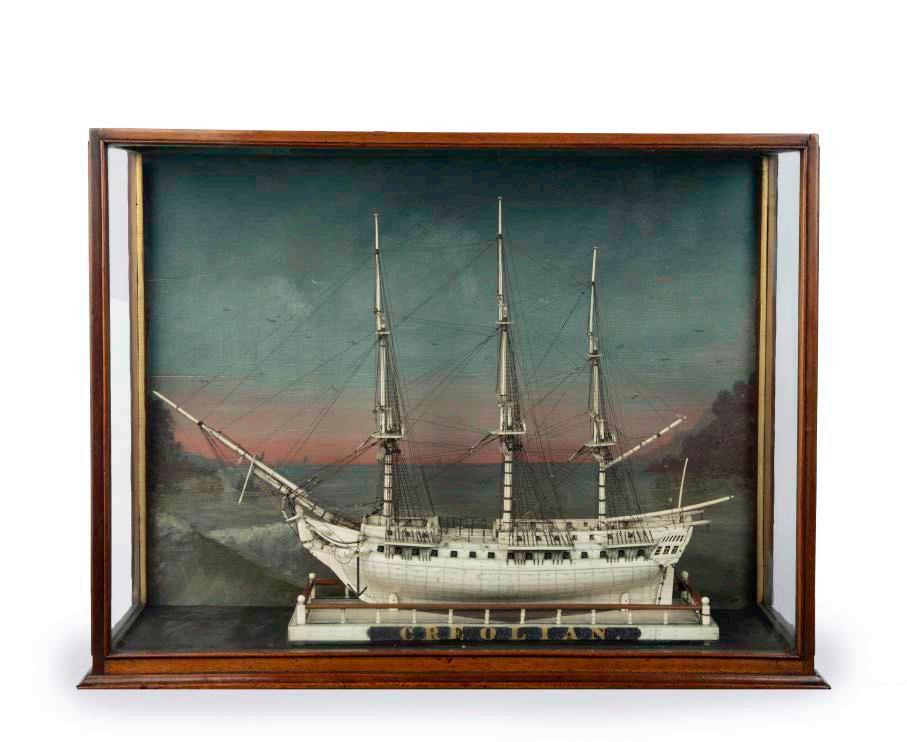
This intricate bone prisoner of war model is of the three masted barque, Creolian . She has a planked hull, a carved poop deck and a female figurehead. The rigging is made from black thread and there is a black plaque painted in gilt ‘Creolian’ . In the original glazed wooden case with a painted background of a sunset over a bay with ships on the horizon. French, circa 1800.
Provenance: Ivan Roll Amis: d. 1 July 1970
Richard Henry Allen Amis, CBE, thence by descent
During the Revolutionary and Napoleonic Wars (17931815), large numbers of French soldiers and marines were taken prisoner. To help pass the time and generate a small income, they would make a variety of objects,
including ship models, from simple, easily-sourced materials such as bone and wood for sale at local markets. Typically, the models were not made to scale and tools were limited, making the quality and attention to detail in this work even more remarkable. To realise a good price at market, the models were often named after famous ships of the time. It may well be that this ship was the Créole , a 40-gun frigate of the French Navy. She served in the Brest squadron, took part in Ganteaume’s expeditions of 1801 to Egypt, and was involved in the French acquisition of Santo Domingo (also known as the Era de Francia) and briefly detained Toussaint Louverture (a prominent leader of the Haitian Revolution).
44
Model height: 24 in (61cm) Case height: 21½ in (55cm) Width: 29 in (74cm) Depth: 10¾ in (27.5cm)
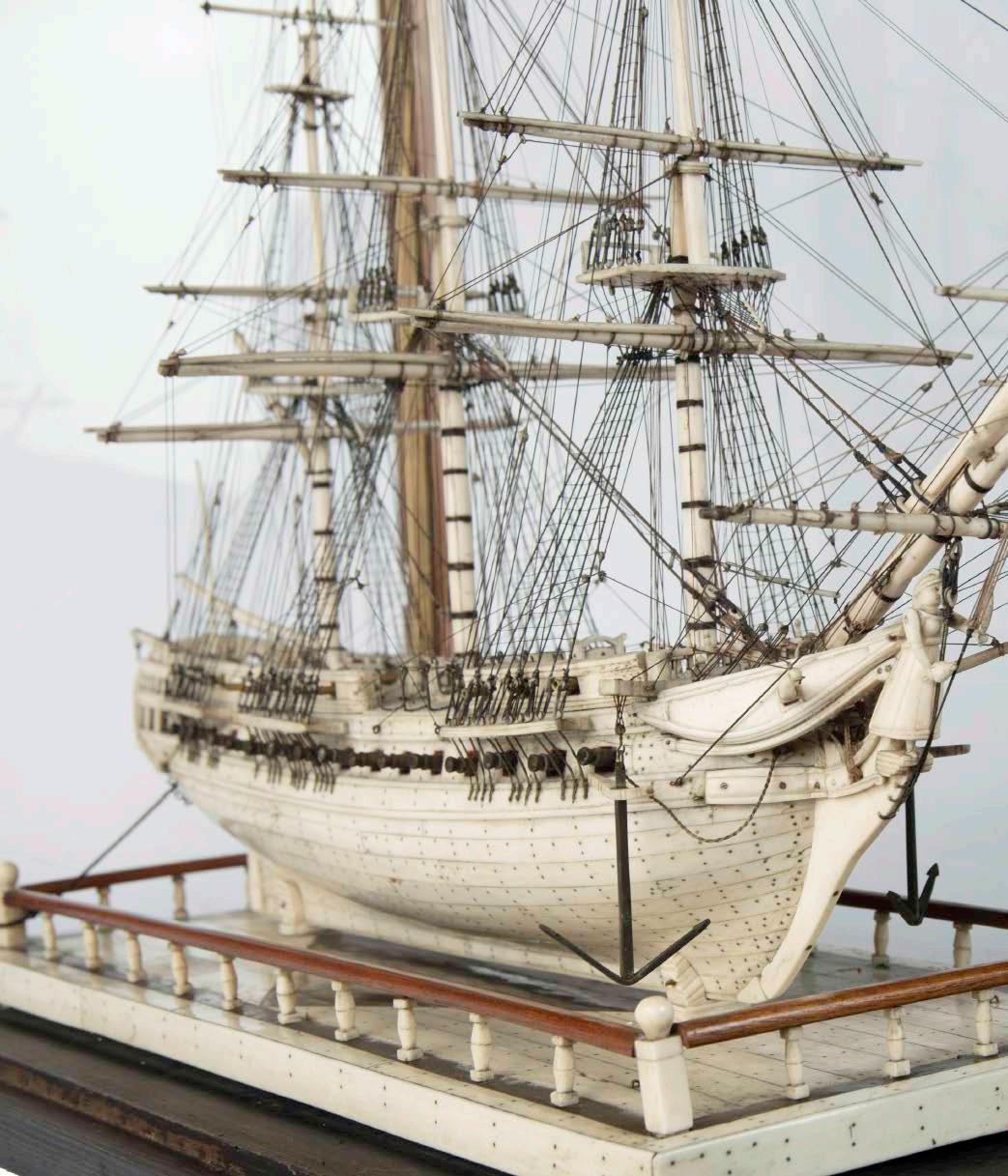
A pair of mahogany 21-inch floor globes by J & W Cary dated 1799 and 1819


Overall height approximately: 47¼ in (120cm ) Diameter: 28 in (71cm)
Each globe is mounted within a brass meridian, fitted within a paper horizon ring. Each mahogany stand has three tapering reeded legs joined by a stretcher centred on a compass rose, terminating in brass cappings and castors. The celestial globe has a cartouche reading "Cary’s New and Improved Celestial Globe on which is carefully laid down the whole of the stars and nebulae contained in the astronomical catalogue of the Revd. Mr Wollaston F.R.S. Compiled from the authorities of Flamsteed, de la Caille, Hevelius, Mayer, Bradley, Herschel, Maskelyne &c. With an extensive number from the works of Miss Herschel, the whole adapted to the year 1800, and the limits of each constellation determined by a boundary line. London: made & sold by J & W Cary, No. 181 Strand, Mar 1 1799". The terrestrial globe has a cartouche reading "Cary’s New Terrestrial Globe exhibiting the tracks and discoveries made by Captain Cook; also those of Captain Vancouver on the north west coast
of America; and M. De Laperouse on the coast of Tartary, together with every other improvement collected from various navigators to the present time. London: made & sold by J & W Cary, Strand, March 1st 1815, with additions and corrections to 1819".
The celebrated Cary family of cartographers and globe makers produced some of the greatest late Georgian globes. The firm was started in London in the late 18th century by John Cary (circa 1754-1835), an engraver and dealer in maps who often worked in partnership with his brother, William Cary (circa 1760-1825), a scientific instrument maker. John Cary concentrated on geographical excellence rather than on decoration. In about 1820 the Cary brothers moved their business to 86 St. James’s Street, leaving the premises at 181 Strand to John Cary’s sons George (circa 1788-1859) and John Jr. (1791-1852) who traded as G. & J. Cary until about 1850.
46

47
A papier mâché ‘smoking’ clay pipe rest based on The Lobster and the Crab


Height: 8½ in (21cm) Width: 8¼ in (22.5cm) Depth: 8 in (20cm) Glass case height: 7¾ in (19.5cm) Width: 13 in (33cm) square
This amusing papier mâché novelty features two pensioners sitting side by side on a bench smoking and drinking. One is a Chelsea pensioner with one arm, wearing a red coat, with a pipe in his mouth and holding a metal tankard. The other is a Greenwich pensioner with a wooden leg and wearing a blue coat. There is a drawer in the back of each figure for resting a lit pipe so that the men appear to be smoking. English, circa 1800.
These two characters are veterans from the Navy (the crab) and the Army (the red-coated lobster) featured in a song by Charles Dibdin. In this 'Dick Dock, a tar
in Greenwich moor'd' (the Crab) provokes the Lobster but is reconciled on discovering he once saved his life. A coloured etching of the same subject by Robert Dighton in 1801 was used to illustrate the two volumes ‘Descriptions of Battles by Sea & Land from the King’s Library at Greenwich in Chelsea’ (credit: The Wellcome Collection) while another version from 1806 was inspired by Isaac Cruickshank’s etching of the same subject normally called ‘The Veterans.’ Papier mâché versions are extremely rare, not least because of the fragile and combustible nature of the material.
48


49
Captain Pryce Cumby's Bellerophon chair

This oak chair was commissioned by Captain Cumby from the timbers of his famous ship Bellerophon. It is of rectangular form with an upright back with four spindles, the cresting rail carved with the ship’s name ‘Bellerophon 1805’ flanked by two scrolls, the arms with further bobbin turned spindles and scrolling terminals, all raised upon turned legs with the original brass castors. A most striking feature is the original gros-point needlework of the upholstery. The arm rests and seat cushion show vivid coral branches, seaweeds and exotic shells including nautilus, scallops, alphabet cones, Junonia, spiny jewel box and argonauta, while the back cushion depicts the ship from the stern, under full sail on port tack and with her flags streaming from the masthead and stern. English, 1807. The very realistic depiction of the shells in this embroidery can no doubt be attributed to the custom of sailors to collect shells for their loved ones. Many were made into pictures or glued into frames as ‘shell valentines’. One of Captain Cumby’s life-long friends (see Hilary Jackson in A Country Durham Man at Trafalgar, Cumby of the Bellerophon) Lieutenant Thomas Symonds, of the sloop
Height: 43in (109cm)
Width: 26in (66cm)
Depth: 30in (76cm)
Tweed, rescued an 11-year old French twin called Lucinde who subsequently wrote a charming book ‘Les Jumelles’ in which she describes going ‘to the bay of Honduras … collecting shells and other curiosities for Captain S., who was making a collection for one of his sisters’. Lucinde and her twin Zébée were orphaned during the siege of San Domingo (Haiti), adopted by Symonds, brought to England and committed to the care of his aunt, Theresa Whitby, at the home of Admiral Sir William Cornwallis. Thomas and Lucinde were married in Boldre where he built her a house named Tweed, they called their youngest son Cumby and the two families corresponded and visited each other in the years after retirement. Around this time Pryce Cumby commissioned two chairs, the present one made from the timbers of the Bellerophon and another from the timbers of Hyperion. Both were exhibited in the Bowes Museum, County Durham until acquired by a private collector, who later sold the Hyperion chair. In his will Cumby left to his wife his Patriotic Fund Sword, all silver and plate marked ‘C’ and ‘his cabinet of shells.’
50

51
Thomas Luny: HMS Bellerophon with the defeated Emperor Napoleon aboard
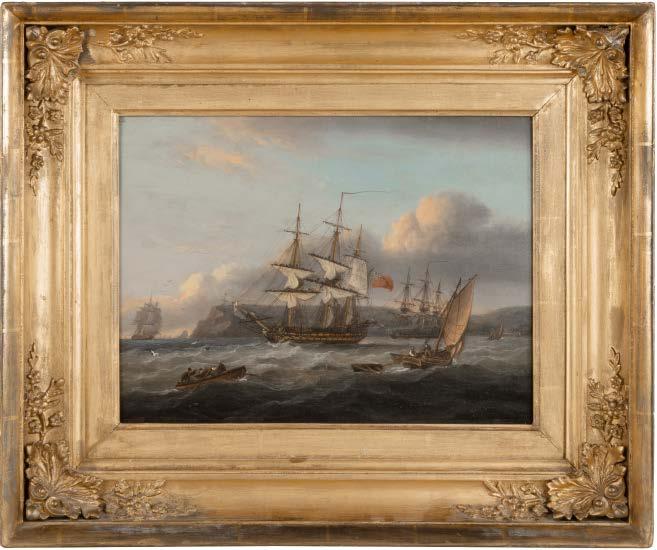
This oil on panel by Thomas Luny (1759-1837) shows Bellerophon leaving Torbay with the defeated Emperor Napoleon aboard, 26th July 1815. Her crew are manning the yards to unfurl the sails, prior to weighing anchor, with another battleship anchored astern, and a further ship under sail in the distance. The foreground has rowing boats approaching. Signed and dated 'Luny 1827' (lower left). In the original giltwood frame. English, 1827.
Provenance: Private collection, UK
Despite a service career as illustrious as any fighting ship in the Royal Navy, Bellerophon is principally remembered as the vessel to whose captain Emperor Napoleon
surrendered after Waterloo and which then conveyed him to Plymouth, via Torbay, on the first stage of his long journey into exile. One of the fourteen 'Arrogant' class 74-gun Third Rates designed by Surveyor Slade in 1758, Bellerophon was built on the Medway. Launched on 17th October 1786, she was measured at 1,613 tons and 168 feet in length, with a 47-foot beam. Fitted for sea in August 1790 and commissioned under Rear-Admiral Thomas Pasley, Bellerophon acted as his flagship at the battle of the Glorious First of June in 1794, where she engaged the huge 110-gun Révolutionnaire alone for an hour and a half before Russell and Marlborough came to her assistance.
52
Height: 11½ in (29m) Width: 15½ in (39.5cm) Framed height: 19½ in (49.5cm) Width: 23 in (58.5cm)
William Pryce Cumby’ silver salver, 1836

This William IV silver salver has a shellwork and scroll border and is raised on four small feet. It is profusely chased and engraved with foliate decoration and inscribed in the centre beneath a widow’s coat of arms: ‘The bequest of Susannah Widow of Capt n David Pryce Cumby R.N. to his Son Capt n William Pryce Cumby R.N. C.B.’ Hallmarked for William Ker Reid, London 1836.
Captain William Pryce Cumby , RN, CB, (1771-1837) was the second son of Commander David Pryce Cumby RN (died 1814) and his first wife Eleanor. Following Eleanor’s death, Commander Cumby married, secondly, in 1783 Susannah Marsh (c. 1758-1836). William Pryce Cumby entered the Navy in 1784 serving in a succession of ships before passing as lieutenant in 1793. A less-than-meteoric rise saw him appointed first lieutenant to Captain John Cooke on Bellerophon , 74-guns, in November 1804. Within a year, Cumby took command of the ship when Cooke was mortally wounded at the height of the Battle of Trafalgar.
Diameter: 16¼ in (41.2cm)
Before dying on his own quarterdeck, Cooke implored Cumby ‘never to strike’ . During the action, Bellerophon sustained a ferocious assault by the French ship L’Aigle requiring Cumby on one occasion to intercept and throw overboard a grenade with a burning fuse which could have destroyed his ship. When L’Aigle eventually limped away, Cumby took possession of two Spanish prizes, Monarca then Bahama . Cumby received the highest praise for his conduct during the battle, being promoted commander and post-captain in quick succession before Nelson’s funeral in January 1806, which he attended in an official capacity as a follower. He subsequently commanded Drydon , 36 guns, and Polyphemus , 64 guns, in the West Indies, before transferring to Hyperion , 42 guns, in which he captured the American brig Rattlesnake after a lengthy chase in the Bay of Biscay. His last appointment was superintendent to Pembroke Dockyard where he died on 27 September 1837, just eighteen months after his stepmother Susannah bequeathed him this silver salver.
53
Captain
Admiral Sir John Duckworth’s George III Silver Salver, by John Mewburn 1813

This heavy, solid silver tray is of oval form with two handles. It has a gadrooned border and is finely engraved in the centre with the coat of arms of Sir John Duckworth, 1st Baronet, which includes the battle honours ‘St. Domingo’ and ‘Minorca’ and the motto ‘Disciplina Fide Perseverantia’ . It is raised on four triangular scroll feet. Assay marks for John Mewburn, London, 1813.
Provenance: Admiral Sir John Duckworth in 1813, presumably to commemorate his elevation to the rank of Baronet in November of that year.
John Thomas Duckworth , 1st Baronet (1748-1817) joined the Navy as a midshipman aged 11. His stellar career did not get off to the best of starts when he was concussed by the decapitated head of one of his shipmates. Not to be daunted by this horrific experience, he was appointed lieutenant in 1771 and captain by 1780. On the Glorious First of June in 1793 he was awarded one of only 18 Naval Gold Medals by Admiral Howe. After his role in the capture of Minorca,
Duckworth was promoted to Rear Admiral and added the word ‘Minorca’ to his coat of arms (as seen on this tray).
Duckworth's actions in 1800 led to the capture of a rich Spanish trading convoy off Cadiz, his share of the prize money netting him some £75,000. In 1801 he was tasked with capturing the Caribbean islands of St. Bartholomew, St. Martin, St. Thomas, St. John and St. Croix by defeating the occupying Swedish and Danish troops. On the successful conclusion of this campaign, Duckworth was promoted to the Order of the Bath. Undoubtedly Duckworth's finest hour came during the war against Napoleon. As the Commander in Chief of the Jamaica Station his blockade of San Domingo and engagement of the French ended in such a catastrophic defeat that was the final naval battle of the war. After his return to Britain, Duckworth received a hero's welcome and continued serving until his death. In his final role as Commander in Chief at Plymouth, he was the final senior naval officer to speak to Emperor Napoleon before he was exiled.
54
Admiral Sir John Thomas Duckworth (1748–1817), by William Beechey. Public domain

Height: 2½ in (6.5cm)
Width: 23½ in (60cm)
Depth: 15½ in (38cm)
Weight: 85.68 oz. troy
55
Nicholas Pocock: HMS Emerald and Amethyst, 1811
This oil painting on canvas shows Emerald under full sail with Amethyst in the distance. The plaque attached to the gilt frame reads ‘ H.M. Frigate Emerald 36 guns (Capt. F L Maitland) and H.M. Frigate Amethyst 36 guns (Capt. M. Seymour) chasing the French frigate Niemen 46 guns in the evening of 5th April 1809. Resulting in her Capture on the following day. Nicholas Pocock 1811.’ Relined, English.
Together with a wooden model of the frigate which is painted with a white hull, black plimsoll line, yellow topsides and red cannon ports. It is raised on the original mahogany stand with turned feet and a plaque reading ‘ HMS Emerald, 36 Gun Frigate, Launched on the Thames in 1795. A scale model ½”-1’ made for Captain F. L .Maitland, her Commander 1806-1811’ . The model has some areas of restoration. English.
See Norman Napier Boyd, The Model Ship: Her Role in History , p.48, pl.33 for a very similar model of HMS Centurion in the National Maritime Museum, Greenwich.
HMS Emerald was a 36-gun Amazon-class frigate designed by Sir William Rule in 1794 and completed on 12 October 1795. She joined Admiral John Jervis’s fleet in the Mediterranean and was later sent to hunt down and capture the crippled Santisima Trinidad , which
had escaped from the British at the Battle of Cape St Vincent. Emerald was supposed to have been present at the Battle of the Nile but in May 1798 a storm separated her from Horatio Nelson’s squadron and she arrived in Aboukir Bay nine days too late. She was part of RearAdmiral John Thomas Duckworth’s squadron during the action of 7 April 1800 off Cádiz, served in the Caribbean under Samuel Hood and returned to home waters in 1806, finally being broken up in January 1836. Nicholas Pocock (1740-1821), followed his father’s profession and was master of a merchant ship by the age of 26. During his time at sea, he became a skilled artist by making ink and wash sketches of ships and coastal scenes for his log books. In 1778 he gave up the sea and devoted himself to painting. The first of his works was exhibited by the Royal Academy in 1782 and he was then commissioned to produce a series of paintings illustrating George Rodney's victory at the Battle of the Saintes. In 1789 he moved to London, where his reputation and contacts continued to grow. He was a favourite of Samuel Hood (who commanded Emerald in the Caribbean) and was appointed Marine Painter to George III. He was also present himself at the Battle of the Glorious First of June in 1794, on board the frigate HMS Pegasus .

56
Credit: National Maritime Museum

Height: 13 in (33cm)
Length: 44 in (112cm)
Depth: 10in (25.5cm)
57
Framed height: 19½ in (48cm) Width: 27 in (69cm)
Canvas height: 15½ in (39.5cm) Width: 23 in (58.5cm)

Height: 12½ in ( 32cm) Width: 16 in (41cm)
These finely detailed ormolu equine portraits show the Duke of Wellington’s Copenhagen and Emperor Napoleon’s Marengo. Each one has some defining features and is presented in a rosewood frame on the original velvet ground with a suspension chain. The slightly stockier horse (above left), with an elaborate deep saddle, long triangular cloth and padded roll, is Marengo. The other, Copenhagen, has a simpler harness and rangier body. English, circa 1860.
Marengo (c. 1793–1831) was Napoleon’s grey Arab war horse named after the Battle of Marengo in Italy. Although technically a pony at 14.1 hands, he was indomitable. Wounded eight times in his career, he carried the increasingly overweight Emperor at the battles of Austerlitz, Wagram and Waterloo. He was also used frequently in the 80-mile gallops from Valladolid to Burgos, which took him five hours! Finally,
he was captured at Waterloo by William, 11th Baron Petre and brought back to stand at stud near Ely, living to the venerable age of 38. His skeleton is displayed at the National Army Museum in Chelsea, London.
Copenhagen (1808-1836) was a 15 hands chestnut racehorse of mixed Arab and Thoroughbred parentage who carried the Duke of Wellington at the Battle of Waterloo. In his first years, he raced in 12 races, winning two and coming third in another seven. Taken to Spain by Sir Charles Vane, he was sold to the Duke who said of him “there may have been many faster horses, no doubt many handsomer, but for bottom and endurance I never saw his fellow” . After the victory, he was retired to Stratfield Saye, the Duke’s country seat, where he lived until the age of 28. The Duke refused a request to have his skeleton displayed next to that of Marengo so he was buried on the estate.
58
ormolu equine
famous
A pair of
portraits of
warhorses Copenhagen and Marengo
A small oak grog barrel made from HMS Victory timber, 1890

Height overall: 11½ in (28cm)
Width: 8¼ in (21cm)
Depth: 6½ in (16.5cm)
This grog barrel is in the form of a small coopered cask with brass hoops. There is a central tap below a porthole at one end and plain glass at the other. The breather hole in top is secured with a turned brass stopper. One
hoop is inscribed ‘Made from the piece of one of the timbers of the cabin from HMS Victory, struck by a round of shot at Trafalgar’ On a later X-frame stand with a plaque reading ‘Victory, Trafalgar, 1805’ . English, circa 1890.
59
An Admiral Lord Nelson commemorative stained glass window

Height: 42½ in (108cm) Width: 46 in (117cm)
This rectangular stained glass window was previously in a pub. It comprises a large central diamond painted in enamels with a full length portrait of Admiral Lord Nelson, bare headed, in dress uniform with medals, holding a scroll inscribed with his famous signal ‘England expects that every man this day will do his duty’ . The four triangular corners combine painted glass with lead seams and each has a scroll dedicated to the famous
victories ‘Bastia’, ‘Nile’, ‘Copenhagen’ and ‘Trafalgar’
The outer border has 12 panels each with two unusual facetted amber roundels within a continuous twisted rope on a red ground within green, white and pale blue banding. All the panels are held in red-painted frames. English, circa 1900.
Provenance: The Lord Nelson Pub, 202 Upper Frederick Street, Liverpool, demolished in 1969.
60

Silver racing scull trophies including one from HMS Hood, 1873-1957

A fine boxed pair of silver presentation oars. Each one is inscribed ‘Duplicate of Ox Un Ch Sculls won by N.M. Bruce’ and ‘Ch Ch, 1911 & 12’ (Oxford University Championships and Champion’s Champion) and enclosed in a black leather box with gilt tooling. Together with a single oar presented in a burgundy leather box from R.R. Rowell, 20 High St., Oxford, Watch and Clockmakers to H.R.H. Prince of Wales. The box has the names ‘A. S. Gulston. Bow R. T. Raikes Stroke. J. L. Shaw. Cox.n’ in a gilt on the base. Assay marks for London, 1873. English.
Pair length: 7½ in (19cm) Single length: 7 in (8cm)
An HMS Hood silver presentation rowing scull . This is set on a Bakelite stand and inscribed ‘Hood 1935 Allcomers Ist, Major O. M. Haworth-Booth’ . English. Length: 8¼ in (21cm) Stand length: 10 in (25.5cm)
Six silver Naval presentation rowing sculls . They are variously inscribed ‘E of I 1928’, ‘H. B. B 3rd Aug 1931’, 'R.N.C.D. Junior Skiffs 1939', 'Mediterranean Fleet Regatta 1949', ‘Seamen 8 1957, HMS Birmingham' and ‘Racing Whaler 1957, HMS Birmingham' . Together with a single scull in a red satin box which is inscribed ‘Second D.F. Officers Whaler Race, 6th September 1926’ . English
The longest: 6½ in (16.5cm)
62

63
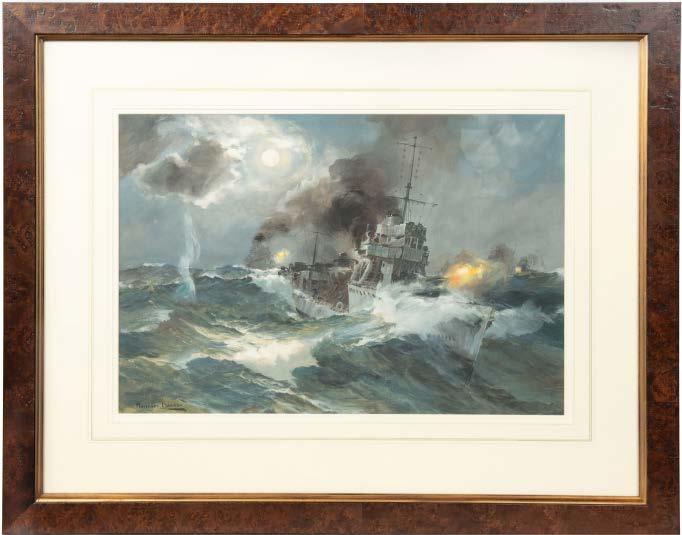
This dramatic watercolour on paper shows a WWI R-class destroyer escorting a battleship through a nighttime encounter in choppy seas. The moon has emerged from behind scudding clouds to illuminate her bow as she makes smoke to mask the battleship behind her. An enemy ship can be seen on her port side and the waterspout from a shell can be seen clearly to starboard. All three ships are firing their guns, the orange flashes bright in the darkness. Written in pencil on the reverse ‘A Moonlight scrap’ . English, circa 1915.
Montague Dawson RMSA, FRSA (1890–1973) was the son of a keen yachtsman and the grandson of the marine painter Henry Dawson (1811–1878). He served in the Dazzle Painting Section at Leith in WWI and in 1924 was the official artist for an Expedition to the South
Seas by the steam yacht St.George . He was present at the final surrender of the German High Seas Fleet and many of his illustrations depicting the event were published in The Sphere . After the war, Dawson established himself as a professional marine artist, concentrating on historical subjects and portraits of deep-water sailing ships often in a stiff breeze or on high seas. During WWII he was once again employed as a war artist and again worked for The Sphere . He exhibited regularly at the Royal Society of Marine Artists, of which he was a member, from 1946 to 1964, and occasionally at the Royal Academy between 1917 and 1936. He was considered one of the greatest living marine artists, whose patrons included two American Presidents, Dwight Eisenhower and Lyndon Johnson, as well as the British Royal Family.
64
Montague Dawson: A Moonlight Scrap
Height: 15 in (38cm) Width: 22½ in (57cm) Framed height: 27 in (68.5cm) Width: 34½ in (86.5cm)
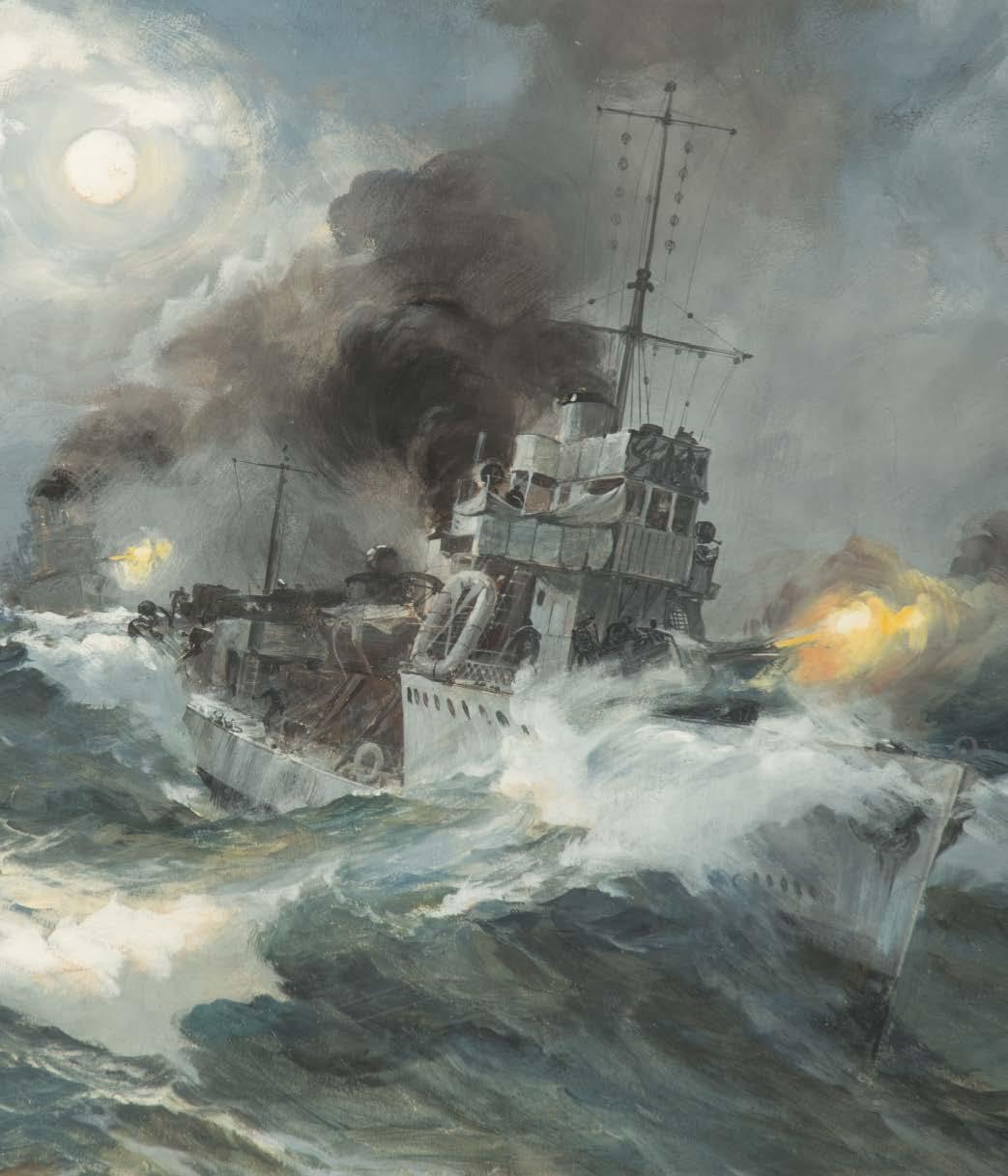
Clarkson Stanfield: The Gulf of Salerno

This oil painting on canvas shows commercial shipping and fishermen in the Gulf of Salerno. The tower at Vietri is visible in the background. There is a three masted barque surrounded by a cluster of sailing boats and service tenders to the right. In the foreground, a pile of nets, a basket and two flagons are scattered on the beach. With a gilt plaque stating ‘The Gulf of Salerno, W. Clarkson Stanfield R.A. Exhib. 1857. No.371’. English, circa 1840.
Provenance: Alan Russett, author of biographies of Dominic Serres, George Chambers and John Thomas Serres ‘The Tireless Enterprise of a Marine Artist’. See page 40 for further information on Alan Russett.
Clarkson Frederick Stanfield, R.A. (1793-1867) was born in Sunderland. As his father was a well-known
actor and his mother an artist, his first artistic endeavours were painting theatrical scenery. In 1808 he went to sea in a collier, was subsequently pressed into the Navy for two years and then sailed as a seaman to China and back. Once home, he resumed theatrical scenery painting and was famous for his ‘moving dioramas’, unrolling land and seascapes, some twenty feet high. At the same time, his easel painting earned him the admiration of William IV and Queen Victoria. She bought several of his oils, including, in 1840, a pair of Italian scenes, ‘A view of the beach at Vietri in the Gulf of Salerno’ and ‘The Capuchin Convent at Amalfi’. He first exhibited at the Royal Academy in 1820 and became a full Academician in 1835. He received several other artistic honours and was appointed Curator of Pictures at Greenwich Hospital in 1844.
66

67
Height: 35 in (89cm) Width: 53 in (135cm)
Four Victorian hardwood mariner’s fids, one dated 1812
Heights: 24 in (60cm) to 30½ in (75cm)
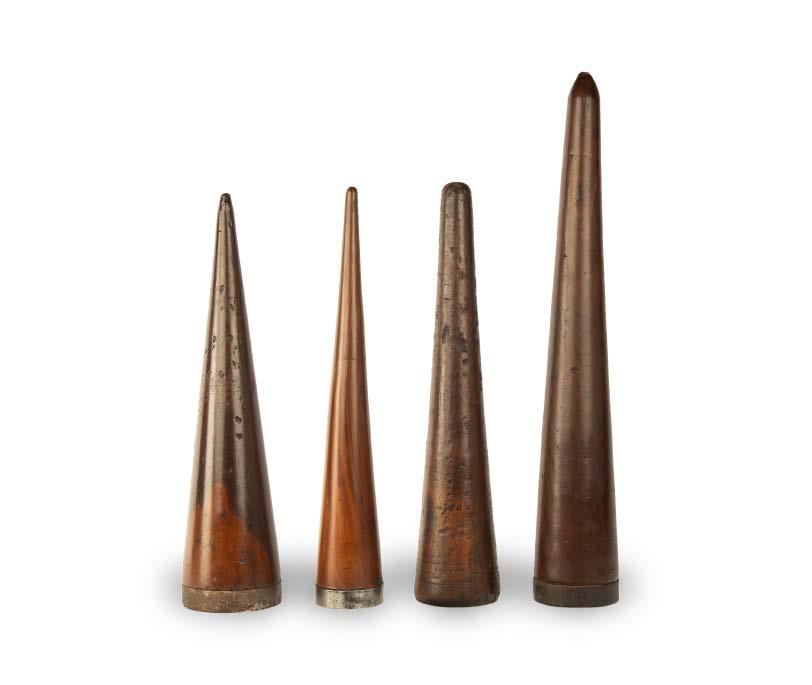
These four large fids are made from different woods and vary in shape. The first, from the left, is ironwood and has a wide conical shape, while the next one is sharply pointed and has a steel collar. The next one to the right is inscribed ‘Scarborough, Harwich, 1812’ . The furthest right is considerably larger and heavier than the others, it also has a metal collar. English, circa 1812.
A fid is a conical tool traditionally made of wood or bone. A large fid, used for rope of more than two inches is called a commander, which is pounded through the rope with a wooden mallet. Sailors' fids were essential items of equipment and had a wide range of uses. For ropework, they were used for holding open knots, untangling rigging and separating individual strands of rope for splicing. In sail-making, they were used for reeving (threading rope through rings and apertures) and
making grommets or eyelets in canvas. A fid differs from a marlinspike in material and purpose. A marlinspike is made of metal and used to open shackles or, in working with wire rope and natural or synthetic lines, to loosen knots.
Fids were usually made from wood, mostly lignum vitae, although examples in oak, teak, elm and even mahogany can be found. Whalebone fids are also common, mostly fashioned by sailors working aboard the North Atlantic whaling ships. It is said that whalebone fids were stronger and more durable than their wooden counterparts, with the added advantage that the raw materials were a by-product of the ship’s catch. During long voyages, sailors would often customise their fids with finely carved details to improve the grip or simply for aesthetic reasons (see the opposite page).
68
An Anglo-American whaler fid set with a Tudor coin and carved with the Stars and Stripes
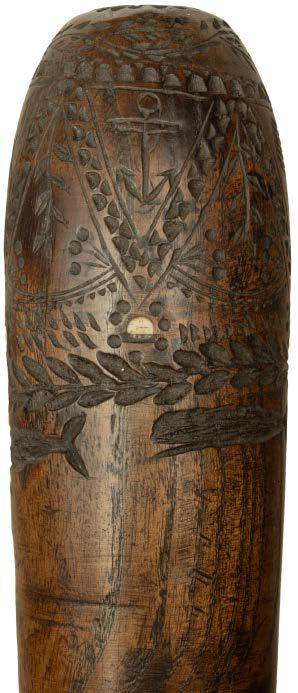
This carved elmwood fid has a sharply tapering tip and rounded end set with a Queen Elizabeth I silver sixpence dated 1562. It is carved with a band of foliage and four triangles variously containing crossed harpoons, an anchor, a flagpole flying the Stars and Stripes with nine stars and six stripes and a shield enclosing three stars above four stripes. The interlocking triangles each have a single foliate spray above flowerheads inlaid with ivory centres, garlands and a band carved with a blue whale and two sperm whales American English, circa 1860.

Height: 22 in (56cm)
Diameter approx: 3 in (8cm)
69

This watercolour on paper is framed under glass and signed in the left corner. It shows an East Indiaman sailing downwind under full canvas. The reverse has a paper trade label from Harlow, McDonald & Co, 667 Fifth Avenue, New York, giving the title “‘Wind Aft’, The Repulse, Water color by Montague Dawson”. Pencil notes give a fuller description ‘The Repulse East Indiaman, 1425 tons. Built in 1820 at Green and Wigram’s Blackwall Yard. She was broken up in 1844 after making many voyages to the East. No. 24733.’ English, Montague Dawson (1890–1973).
East Indiaman was a general name for any sailing ship operating between East India and Europe from the 17th to the 19th century. This included Austrian, Danish, Dutch, English, French, Portuguese and Swedish vessels. Some of the British ships were also called tea clippers.
Repulse was a first-class East Indiaman built in the Blackwall Yard during the last days of the East India Company. The image (right) is a lithograph by Hudson titled ‘The Repulse East Indiaman in East India Dock Basin, Sepr. 25th, 1839’ in the collection of the National Maritime Museum, Greenwich, No. 140483. Dock basins allowed ships to load and unload during all stages of the tide. See page 64 for a biography of Montague Dawson.

70
Montague Dawson: Wind Aft, The Repulse
Photo credit Wikimedia Commons Height: 16½ in (42cm) Width: 26½ in (67.5cm) Framed height: 18½ in (47cm) Width: 28¾ in (73cm)
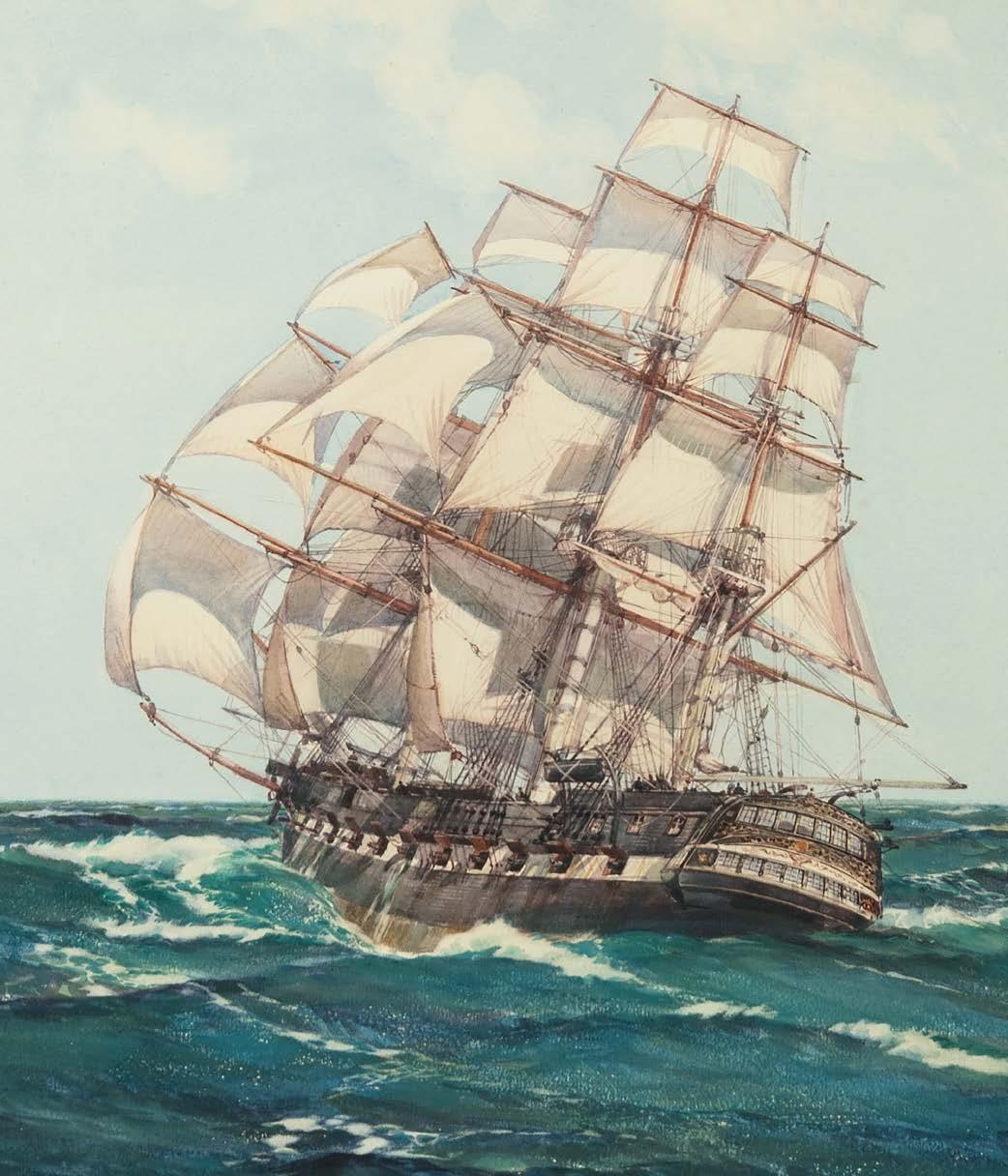

This long yacht tiller is made from a single, solid piece of mahogany and has a typical shallow S-curve. The terminal is carved with the head of the young Queen Victoria. Below this is a brass-mounted grip and a long section carved to simulate multiple strands of twisted rope. The square section end, which has a socket for the rudder, is decorated with panels of acanthus leaf scrolls. English, circa 1840.
The scale and quality of this impressive tiller indicate that it would have been created for a major yacht of its
era, one that would have been about 100 feet in length. The ‘Sunday’ tiller of America (see pages 104-107), which is in the lobby of the New York Yacht Club, is 96 inches long and the tiller from the 1895 America's Cup Challenger Valkyrie III tiller is 148 inches and hangs in the Royal Ulster Yacht Club, Ireland. A ‘Sunday’ tiller is a finely crafted decorative, but also functional, tiller used on high days and holidays. There would have been a different tiller for racing and transatlantic crossings.

72
A large ship’s ‘Sunday’ tiller carved with Queen Victoria’s likeness
Length: 110 in (280cm) Max. height: 7 in (18cm) Max. width: 4½ in (11.5cm)


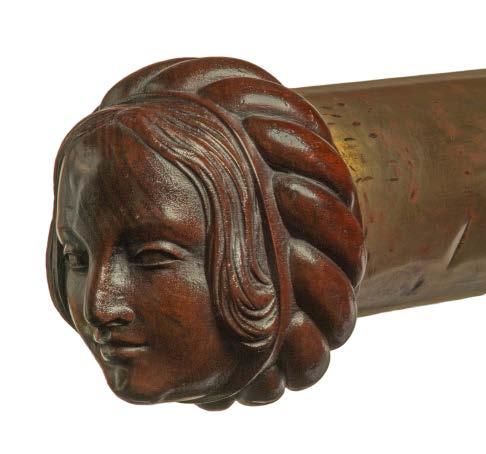 Queen Victoria by Franz Xavier Winterhalter, circa 1840.
Queen Victoria by Franz Xavier Winterhalter, circa 1840.
73
Credit: Archives of Canada
An ormolu mantel clock with Queen Victoria in medieval dress, by Monroux, 1832


This fine and unusual mantel clock is a rare model produced in France for the British market. The case incorporates a finely cast and chased figure of a lady in medieval dress, almost certainly Queen Victoria herself, based on the costumes worn at the Bal Costumé of 12th May 1832. The drapery and fringes are beautifully detailed with burnished edges, as is the Queen's crown on a cushion on the floor by her feet. The shaped base of the clock incorporates the coat of arms of the British royal family with lion and unicorn supporters. The clock features silk suspension and a French drum movement, striking on a bell, and the dial is signed with the name of the prominent retailer Monroux of 221 Rue St Honoré, Paris. French, 1843.
The Bal Costumé of the 12th of May 1842 . At first glance this clock may not appear to fit in with our theme ‘heroic endeavour’ but the story behind Queen Victoria’s
costume is an inspiring one. Attended by some 2,000 guests, the Bal Costumé was a fancy dress party designed to re-invigorate the Spitalfields silk trade which had been coming under increasing pressure from imports, particularly those from France. All attendees were encouraged to use Spitalfields silk in their costumes and the theme was the medieval period, the King and Queen basing their costumes on the effigies of Queen Philippa of Hainault and King Edward III in Westminster Abbey, which were immortalised by Sir Edwin Landseer. So influential were the costumes worn on the night that the industry in London was saved amidst the plethora of new orders. Drawings from the original dresses by Coke Smyth were printed by J.R. Planche and later published by Colnaghi as a ‘Souvenir of the Bal Costumé’. Further designs for the costumes were included in the inaugural issue of the Illustrated London News .
74
A plate from Planche’s ‘Souvenir of the Bal Costumé given by H.M. Queen Victoria at Buckingham Palace, May 12, 1842’
Height: 15¼ in (38.5cm)
Width: 13¼ in (34cm)
Depth: 5½ in (13.5cm)
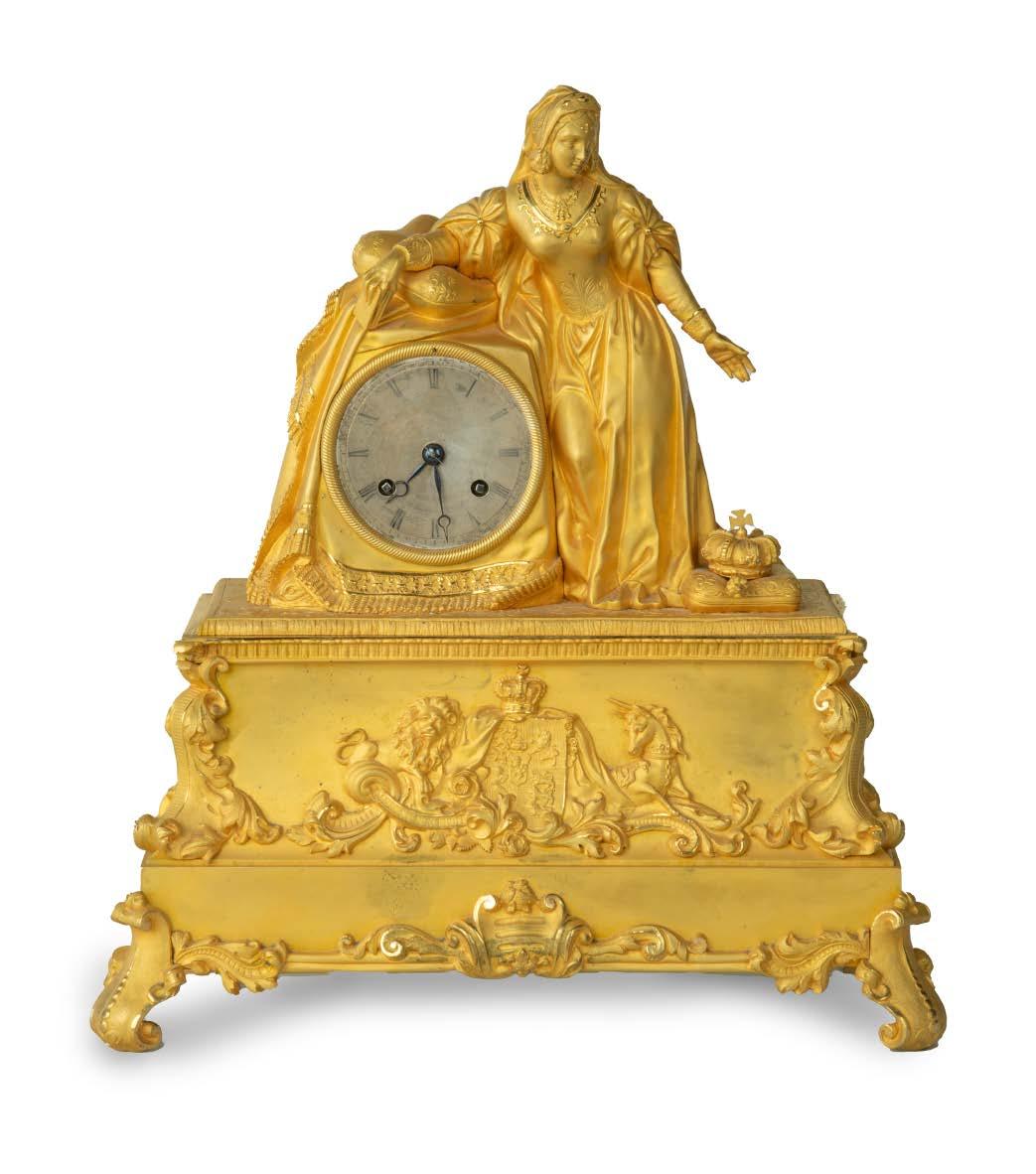
75
Andrew
Morton R. A.: Captain George Treweeke Scobell, 1840


This oil on canvas half portrait shows a bearded Capt. G.T. Scobell looking to his left and wearing a black frock coat with a high collar, a white shirt and wide cravat. His right hand is tucked into the front of his coat while his left hand wears a signet ring and holds a tan leather glove. Signed and dated ‘A Morton, 1840’ and with a paper label for Frost & Reed on the reverse. There is also a bundle of Scobell family documents. English, 1840.
Provenance: Private collection by descent.
Captain George Treweeke Scobell (1785-1869) joined the Royal Navy as a midshipman aged 12. Initially, he served under Captain Pender on the coast of North America, and subsequently in the expedition to Copenhagen under Sir Clyde Parker and Lord Nelson in the blockade of Cadiz. He was made lieutenant in 1804, and commander on 1st February 1812. In 1823 he invented and submitted a ‘Dissecting Paddle-wheel’ to be worked by winches which, with only 20 men operating them, produced a speed of one and a half knots. They were used on Sir William Parry’s expedition to the North Pole. Scobell retired from the Navy in 1843 and was elected Liberal M.P. for Bath in 1851. In the later stages of his life he was a magistrate for Somerset and High Sheriff in 1863. In his will his beneficiaries were
his nephews, Barton Laud John Scobell (see following pages) and Sandford George Treweeke Scobell.
In 1854 Captain Scobell put a motion before the House of Commons that an 'Order of Merit' should be awarded to 'persons serving in the army or navy for distinguished and prominent personal gallantry.... and to which every grade and individual from the highest to the lowest.... may be admissible'. The medal was named the Victoria Cross (V.C.) and awarded for valour ‘in the presence of the enemy’ for actions in the Crimean War (1853-1856). The first, together with a pension of £10, was awarded by Queen Victoria in 1857. Subsequently, the V.C. has remained the highest and most prestigious decoration of the British honours system. There have only been 1,354 recipients (three of whom have won it twice).
Andrew Morton (1802–1845) was an English portraitpainter, born in Newcastle upon Tyne, who studied at the Royal Academy, gaining a silver medal for his first exhibit in 1821. Once established he had many notable commissions, including William IV in National Maritime Museum, Greenwich, the Duke of Wellington in the Wallace Collection and several in the National Portrait Gallery.
76
The Victoria Cross medal

77
Framed height: 42 in (107cm) Width: 32¼ in (80cm)
Lt. Colonel Barton Scobell’s presentation silver to the Royal Artillery, 1886

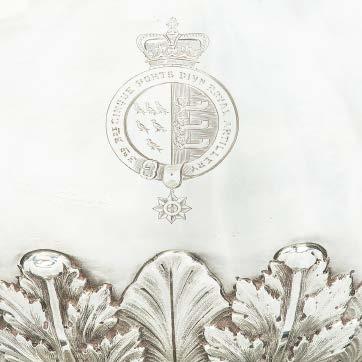
Cup height: 18½ in (29cm) Diameter: 12 in (30.5cm) Max. width: 17½ in (45cm) Height overall: 29 in (50.5cm)
This substantial and impressive gift is in the form of a footed cup with square-shouldered handles. The cup has a key pattern border and is incised ‘Presented to the Officers of 3rd Bde. Cinque Ports Divn. R.A. by Barton Scobell Major & Lt. Colonel after 28 years in service with the Regiment, May 1886’ on one side and ‘3RD Bde. Cinque Ports Divn. Royal Artillery’ around a crowned armorial on the other. The cup is set on a black plinth applied with silver regimental crests and field cannon. It has a gilded interior. There is an inscription around the foot and a matching label inside the stand saying ‘J.D. Harris, Goldsmith, Jewellers & Silversmith, 5, Queen Square, Bath’ , assayed for London, 1884.
Provenance: Private collection by descent.
Barton Laud John Scobell (1836-1913) was descended from a long line of Sussex gentry, who were also doctors, clergymen and soldiers, many of them later serving with honour in the First World War. He studied at Exeter College, Oxford and the Inner Temple. The Scobells were major landowners, having estates not only in Sussex and Somerset but also in Devon and Dorset. On the
death of his uncle, Captain G. T. Scobell (see previous pages), in 1869, Barton inherited Kingwell Hall in Somerset and it became his primary residence, but he maintained a property near the coast in Bournemouth called Littleton Lodge. His major interest was cricket with his private pitch at Kingswell often hosting visiting teams of professional and amateur status alike.
According to his obituary, Scobell was a 'magistrate for over forty years, chairman of the Temple Cloud Bench and a member of the Keynsham Bench.' His sense of civic duty and belief in the rule of law made him a perfect Militia man and he appears to have served with distinction in his regiment and been popular with his men. An article in the Newbury Weekly News and General Advertiser , 26th November 1874, reported on Scobell's marriage and the eminent guests who attended. Interestingly Scobell received an 'epergne with silver pedestal and base' , presented to him by 'his brother officers and men of the regiment' and it is likely that the present piece was presented to the Regiment, at least in part, in gratitude for this previous token of esteem.
78
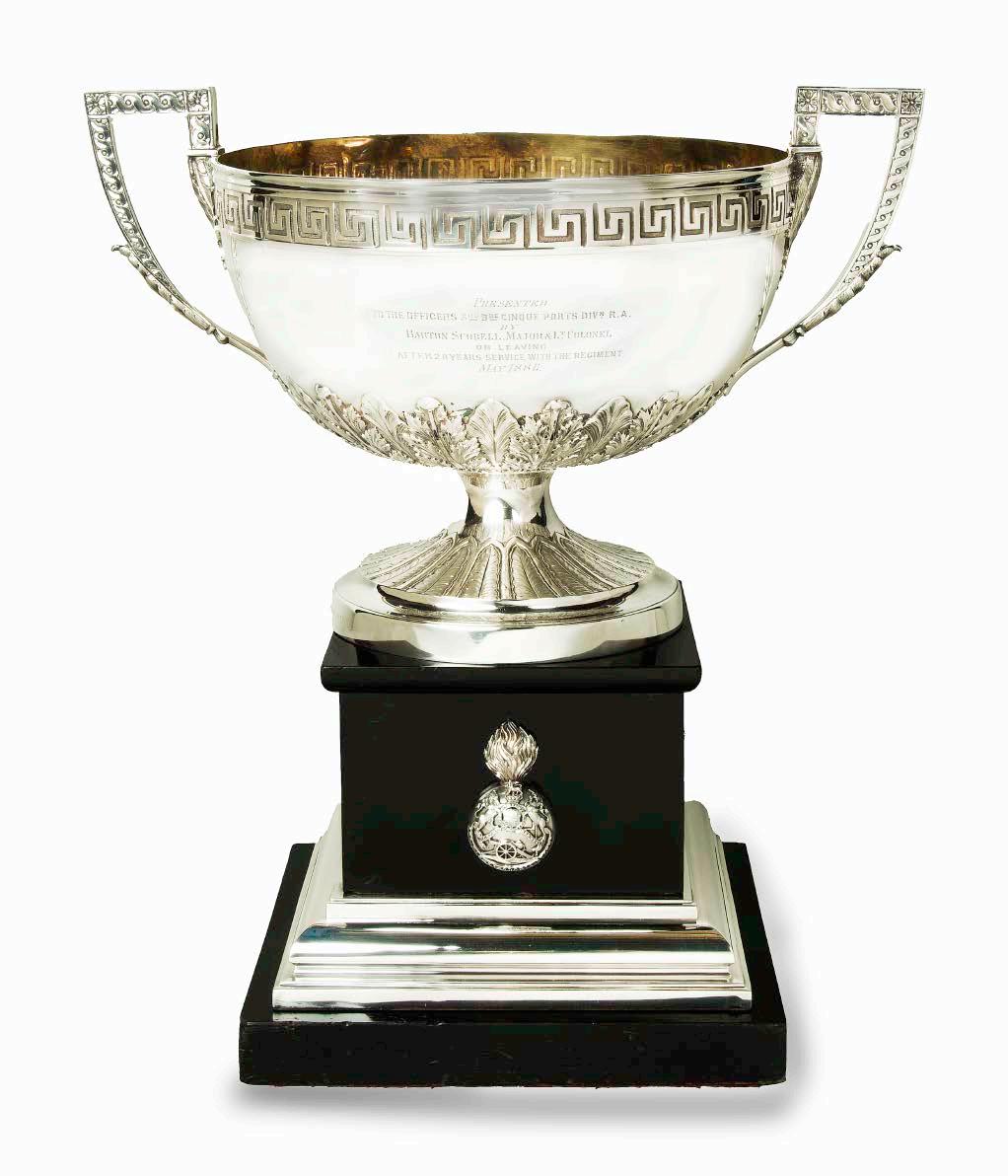
79

This planked model of a Thames pleasure boat is made of mahogany with copper pins. There is a broad passenger seat behind four thwarts, two of which are adjacent to oar locks set into the saxboard. The two oars have metal tips and leather collars. The bow has a brass rubbing strake with a fleur-de-lys attachment and two padded cushions for a small seat, while the stern is fitted with a yoke tiller on a working rudder. The model is raised on two brass supports on a mahogany double cruciform stand. English, circa 1885.
Open rowing boats have been a commonplace feature on the River Thames for hundreds of years as passenger wherries. However, the Victorians, and later the Edwardians, developed a passion for boating as a leisure activity, as shown in the famous painting of Boulters Lock on a Sunday afternoon by Edward John Gregory. 800 boats and 72 steam launches passed through Boulter’s Lock on a single Sunday in 1888. Punts and rowing skiffs were the preserve of the more athletic enthusiasts, with Henley Reach hosting the first race between Oxford and Cambridge in 1829 and the First Henley Regatta a decade later. We have silver rowing scull trophies on pages 62-63 and some glass slides of the Regatta of 1907 in Sir Harold Dudley Clayton’s collection on pages 26-27.
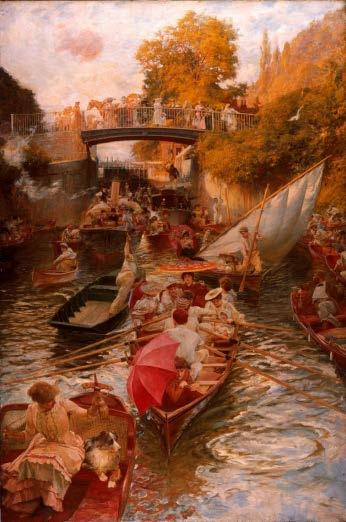
80
A fine and large model of a Thames wherry
Height: 7 in (18cm) Length: 50 in (127cm) Beam: 9¾ in (25cm)
‘Boulter’s Lock, Sunday Afternoon’ by Edward John Gregory. Photo credit: Lady Lever Art Gallery

81
Case height:
30 ½ in (78cm)
Width: 39 in (99cm)
Depth: 13 in (33cm)

This scale model of a Hastings lugger is very similar to the one described in E.W. White’s book as typical of this type of fishing vessel. She has an extremely wide beam,

centreboard, lute stern and two masts, which are stepped in tabernacles for ease of lowering. She could carry up to six men and has wide covered holds for the catch. The mainsail has two sets of reefing lines and the topsides are painted black. There is a hauling post at the foot of the mast. It is presented in a glass case. English, circa 1880.
Published: E. W. White, British Fishing-Boats and Coastal Craft , Science Museum, London, 1952, Vol. 2, pp. 21-21, pl. 52.
Provenance: From a private collection.
Hastings Luggers were the largest of the three types of fishing boat on the South Coast of England used in the 19th century. They were between 27-30 feet, had deep bilge keels and displaced 7 to 16 tons. Bogs were 4 to 7 tons and punts 15 feet overall. The weight of the build was limited by the fact that these open boats were launched and hauled out, over greased skid boards, by capstan. Please see pages 20-21 for a painting of a Hastings Lugger being launched.
82 A gaff-rigged Hastings lugger circa
1880
Plate No 22 from British Fishing-Boats and Coastal Craft
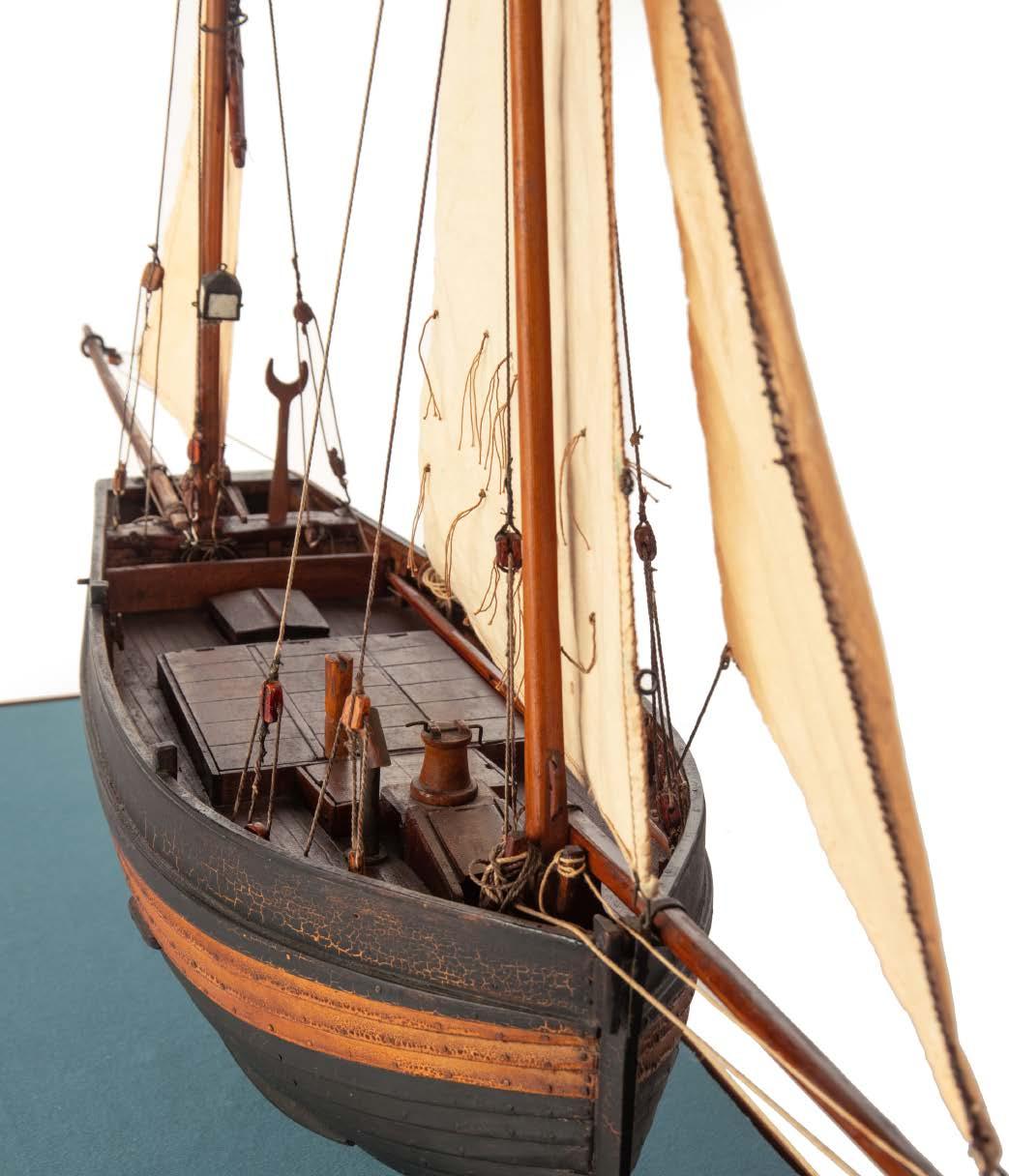
83
William Lionel Wyllie: Newbiggin Bay, Exhibited at the Royal Academy, 1893

This oil painting on canvas shows the broad sweep of Newbiggin Bay in Northumberland with fishermen preparing to launch two open cobles. In the foreground one man is salting fish in a barrel alongside several large cod, crabs, baskets, a float with a marker flag and a launching dolly. Behind him two crews are pushing their craft into the waves while a woman paddles back to shore with a fish basket on each hip, watched by a small dog. There are numerous other boats at anchor and under sail in the background. Signed and with a label on the gilt frame stating ‘W. L. Wyllie (1851-1931) Newbiggin Bay (Exhibited Royal Academy 1893)’.
Exhibited: The Royal Academy, 1893.
The Newbiggin Lifeboat Station was established in 1851 by the Duke of Northumberland , who paid for both a lifeboat and a house for it. This was the direct result of the bravery of one Philip Jefferson and his crew. On the 18th of March 1851 they clawed their way through a ferocious storm to the safety of the bay, in an open coble
like the ones above, only to find that others had not been so fortunate. Risking their own lives, they put straight back out to sea and saved 10 lives. A second famous rescue unfolded on 4th February 1940. The lifeboat was unable to reach the ship Eminent from the bay because of the ferocity of the storm. The lifeboat was landed and re-launched on the other side of Church Point, having been dragged through the wind and snow by some 60 helpers, mostly women, resulting in the rescue of the ship. This episode became the inspiration for the Jack Higgins novel ‘Storm Warning’.
William Lionel Wyllie (1851-1931) was a prolific English maritime artist in oils and watercolours and the father of Harold (see page 117). He has been described as ‘the most distinguished marine artist of his day.’ His works can be seen in the Tate, the Royal Academy, the Imperial War Museum, the National Maritime Museum, the National Museum of the Royal Navy, and many other institutions around the world.
84
Framed height: 29 in (74cm) Width: 56 in (142cm)


This oil painting on canvas shows South Australian, rolling to port and carrying only six main sails and one jib. The port light gleams on the rail. It is signed and has a label on the frame stating ‘Henry Scott’. English, Henry Scott (1911-2005).
Provenance: Purchased from MacConnal-Mason and Son Ltd. London in 2002 for $10,200 (receipt included).
Henry Scott (1911-2005) was a British marine artist noted for his ships’ portraits and coastal subjects. He executed several paintings of British and American clippers for wealthy patrons. In 1970 Scott was commissioned to paint ‘Morning Cloud’ which was skippered and owned by the then Prime Minister, The Right Honourable Edward Heath, P.C., M.B.E., M.P. He exhibited at the Society
of Marine Artists, The Royal Exchange, London, The Guildhall, London and The Royal Academy. Abroad he staged shows at the St. Malo Museum, France and Madison Square, New York. He was honoured as a Fellow of the Royal Society of Arts and awarded an honorary life membership of the International Association of Master Mariners.
South Australian was built by William Pile, Sunderland in 1868. For nearly two decades she voyaged annually between London and South Australia. After being sold in 1887 she operated out of Belfast carrying cargo to India and New Brunswick. She sank in the Bristol Channel in 1889, with the loss of one crew member, when her load of iron railway rails shifted and holed her below the waterline.
86
Henry Scott: Clipper Ship South Australian in Heavy Seas
Height: 24 in (61cm) Width: 36 in (92cm) Framed height: 30½ in (76cm) Width: 42 in (107cm)


A model of a Nathan Thompson Jr patent folding life preserving seat, circa 1853

Height: 5½ in (14cm) Width: 5 in (12.5cm) Depth: 4¼ in (11cm.) Length open: 10¾ in (27.5cm)
This unusual rosewood model of a seat is in the form of a stool split down the middle. It comprises a sealed air-tight unit fitted inside each half of the seat. The whole piece unfolds at the hinged legs, which are then secured with sprung loaded clasps. It is painted overall
with two empty cartouches within gold lines. There is a silver label on an inner face inscribed ‘Patent Folding Life Preserving Seat Invented by Nathan Thompson Jr., New York USA. 1853.’

88
An American half hull mahogany model of a ship’s boat

This half hull is composed of eight mahogany planks and is fitted with fine quality brass fittings including a rubbing strake, a rudder and skeg. There are scuppers
along the water line and exits for the self-draining cockpit at the base of the hull. American, circa 1910.
89
Height: 10 in (25.5cm) Length: 33½ in (85cm)
A Union Jack from Shackleton’s Imperial Trans-Antarctic Expedition 1914-1917
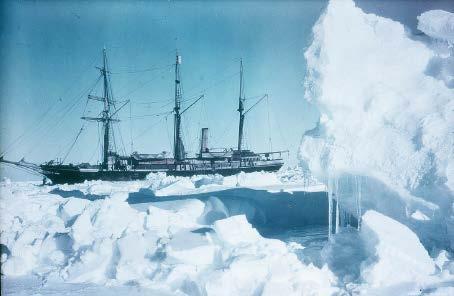
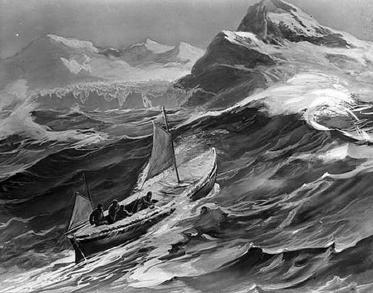
This small handmade silk Union Jack was carried by Dr Robert Selbie Clark (1882-1950). It is framed together with an envelope addressed to 'Miss Laura Richards, 68 Durnford St, Stonehouse Plymouth' over inscribed 'The enclosed little flag I gave to Dr Clark before leaving for the Antarctic. It was returned to me on his return with Sir Ernest Shackleton' , with Penzance and Plymouth postmarks dated '27th April 1914'
Provenance: Miss Laura Richards to her sibling and spouse, thence to their grandson.
Miss Laura Richards was the vendor's Great Aunt, who died tragically when her house in Tavistock caught fire around 1963/4 (she had moved there from Plymouth). He remembers going to the property with his parents to clear her belongings. The flag was found in its accompanying envelope on which she had written the story. Soon after, he was given the flag by his grandparents (Laura's sibling) as he had taken a liking to it on that day. Apparently, the vendor's grandparents had known of Aunt Laura's possible romantic connection with Dr Clark.
Dr Robert Selbie Clark was a Scottish Marine Zoologist who was the Marine biologist aboard Endurance on Sir Ernest Shackleton's (1874-1922) Imperial Trans-Antarctic Expedition 1914-1917. When Endurance became lost to the ice pack, Clark travelled with Shackleton on the James Caird to Elephant Island and stayed there with the remaining crew while Shackleton set off for assistance. Clark remained on Elephant Island for four months until Shackleton's return aboard Yelcho on 30th August 1916.
The voyage of the James Caird was a journey of 800 miles (1,300 kilometres) from Elephant Island in the South Shetland Islands through the Southern Ocean to South Georgia, undertaken by Sir Ernest Shackleton and five companions to obtain rescue for the main body of the stranded Imperial Trans-Antarctic Expedition of 1914–1917. The epic journey was ultimately successful with all 28 explorers saved. Many historians regard the voyage of the crew in an open 22’ 6” (6.9 m) ship's boat through the "Furious Fifties" as the greatest small-boat journey ever completed. Flag height: 2 in (5cm) Width: 2¼ in (5.5cm ) Framed height: 18 in (46cm) Width: 11 in (28cm)
90
Endurance ice-bound and the James Caird (Photo credits Wikimedia Commons)

91
A cased shipyard model of S.S. Burbridge/S.S. Burcombe, 1912

This single model depicts two sister ships. It has black painted topsides, pink hull and dark grey decks. There is a black funnel between two white painted cabin blocks with lifeboats on davits. The deck fittings include two cranes, capstans, windlasses, a boarding ladder, etc meticulously rendered in brass. It has twin specification plaques and is raised on four brass supports. It is presented in a glazed mahogany case with turned and fluted pillars on a later stand.
Provenance: The Estate of the late John Rollo Somerset-Paddon, formerly of Chalk Newton House, Maiden Newton, Dorset, thence by descent. Neither of these sister ships survived for long. Both weighed 3505 tons gross and were built by Richardson, Duck & Co for Burdick & Cook, managers of the Burcombe Steam Navigation Company. SS Burbridge (no. 614) was launched in 1912 and wrecked on the Almadi Reef on a voyage from Beira to London two years later. SS Burcombe (no. 631) was launched in 1913 and torpedoed in 1916.
92
Height:
20 in (50cm) Width: 56 in (143cm) Depth: 16½ in (42cm) Overall height on stand: 53 in (135cm)
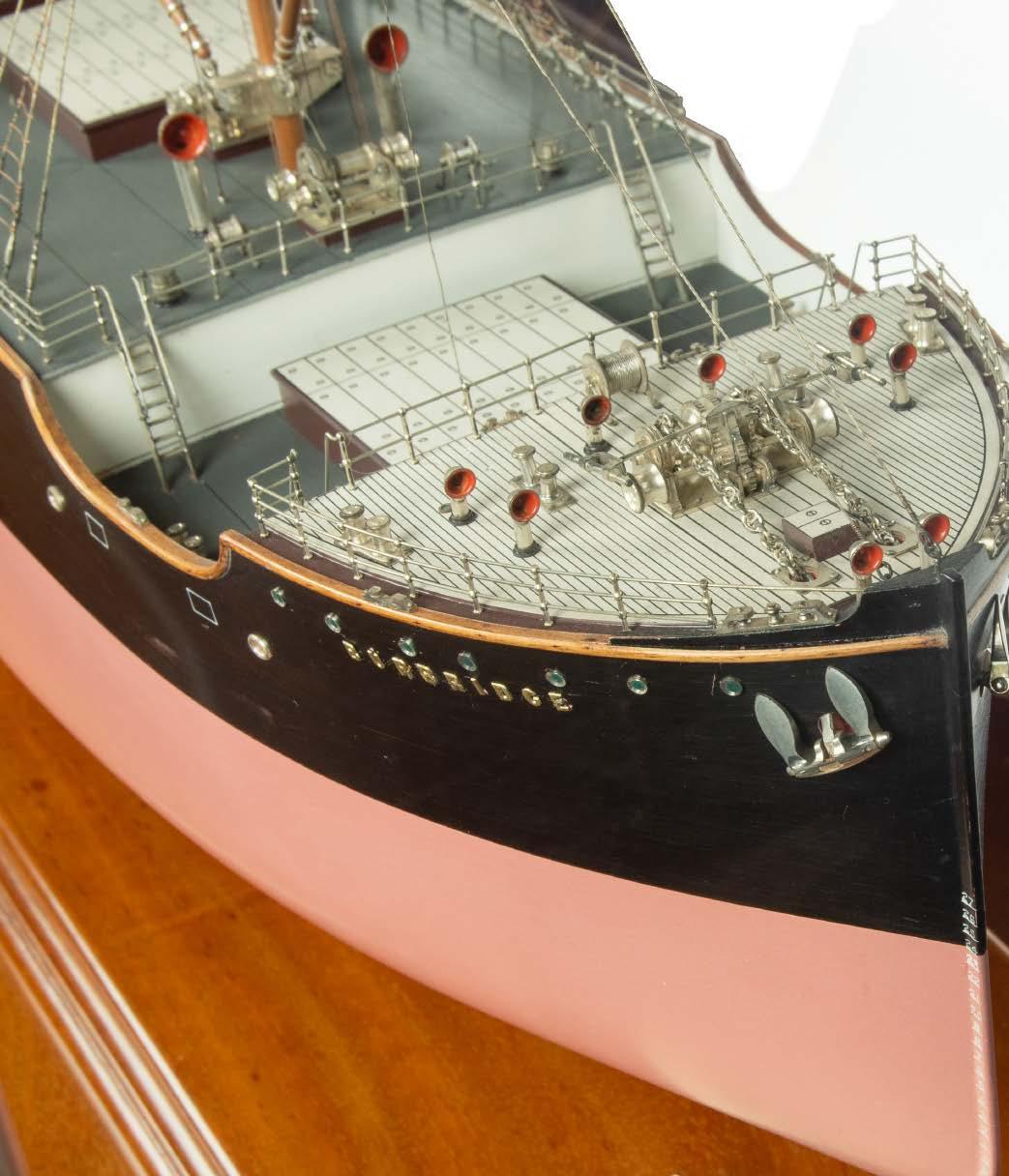
A
Diameter: 14 in (36cm)
Height overall: 39 in (100cm)

This bronze ship’s bell is incised with the legend ‘Ballarat’ and has a suspension bracket and plaited rope bell-pull. The interior is painted white. It is impressed on the shoulder ‘(John R)oby Ltd, Rainhill’. English.
There were four ships called ‘Ballarat’ built for the Peninsular & Oriental Steam Navigation Co (still operating cruise ships today as P&O). They were named after a gold rush town in Central Victoria, Australia, derived from two Aboriginal words meaning ‘resting place’. The first one from Greenock, Scotland (1882-1904) was spelt ‘Ballaarat’. She carried cargoes as varied as troops mobilised for the Boxer Rebellion and a record quantity of Australian butter. The second Ballarat, launched in 1911, was requisitioned by the British government as a troopship carrying first Indian, and then Australian troops. With terrible irony, she was torpedoed in 1917, on her thirteenth voyage, just as the Australian officers were preparing a memorial service for ANZAC Day. In an amazing feat of skill and discipline, all 1,752 on board were taken off the sinking liner within an hour. The third Ballarat was with P&O from 1921 until 1935. After an eventful career frequently delayed by strikes and other setbacks, including hitting a submerged object near the Suez Canal, she was retired due to ‘lack of gainful employment’. The fourth Ballarat (1954-1968) was initially employed for the Australian wool trade and carried the first containers of Australian canned fruit to London in 1966.

94
brass ship’s bell from Peninsular & Orient liner S.S. Ballarat
The evacuation of troopship Ballarat in 1917. Credit Australian War Memorial
A
working model of a ship’s personnel lifeboat on davits

This fine mahogany working model of a ship’s rowing boat is suspended from two davits. It has four thwarts, a white painted interior and silvered davit hooks in the bow and the stern. It is secured on shaped rests and a mahogany base with chamfered edges. English, circa 1920.
Provenance: Arthur Edward Swain and thence by descent.
It is most unusual to find a working model showing davits in operation. Arthur Swain was a marine engineer involved with weapon design during and after World War II and then the Princess flying boats, before joining the United Nations in the Industrial Development Organization. The Saunders-Roe Princess was developed and built in Cowes, Isle of Wight in the 1950s, and intended to serve the transatlantic route, carrying up to 100 passengers between Southampton and New York City in luxury and comfort. Despite three
aircraft being built, delays and problems with the Bristol Proteus turboprop meant they never flew commercially. The Princesses were the largest all-metal flying boats ever constructed.

95
Height: 12 in (30cm) Width: 30½ in (77cm) Depth: 8 in (20cm)
Princess Flying Boat, wiki commons public domain
A cased ship’s model of S.S. Mervyn by
Robert Thompson & Sons, 1924

This shipbuilder’s model has a pink hull, black topsides and a yellow and black funnel. It is executed in meticulous detail with two masts with cargo lifting arms, rigging, a propeller and two white painted accommodation areas with lifeboats on davits. An ivorine plaque details the design, owners’ names and dimensions of the ship. The whole is raised on four turned brass supports and set in a mahogany and glass case, on a separate mahogany stand. Sold with a handwritten receipt of purchase from Romain, Coleman & Co Solicitors, Walthamstow for £350 dated 30.04.72. English, 1924.
Provenance: The Estate of the late John Rollo Somerset-Paddon, formerly of Chalk Newton House, Maiden Newton, Dorset and thence by descent. SS Mervyn was built by R. Thompson & Sons of Sunderland in 1924, weight 3402 tons and 337 ft long. She was owned by Martyn, Martyn & Co, Cardiff. She sank after a collision with SS Langleeford on 01.11.39 10 miles southeast of the Smalls Lighthouse whilst carrying a cargo of coal. Case height: 19¾ in (50cm) Width: 52 in (132cm) Depth: 12½ in (32cm) Overall height on stand: 55 in (140cm)
96

A superb cased owner’s model of the Lord Cochrane, 1934
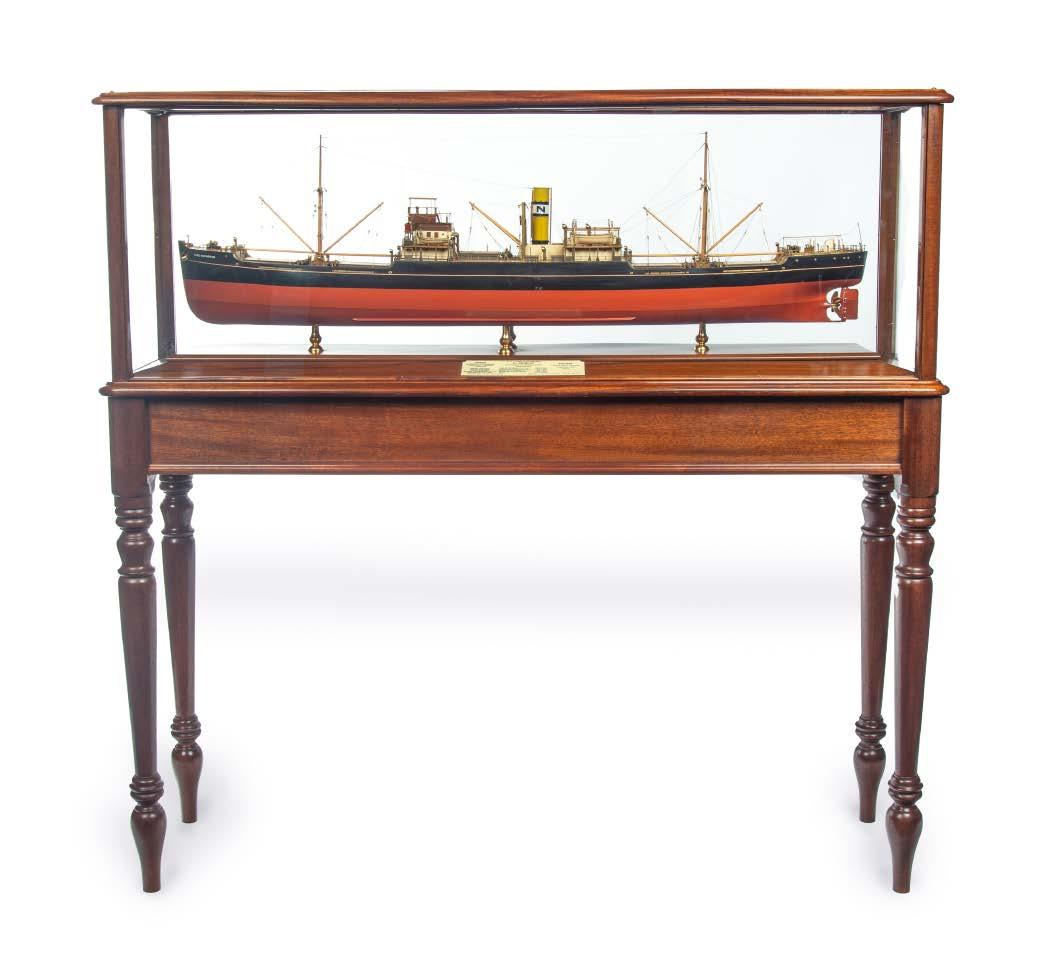
This fine model has a rust coloured hull, black topsides and a yellow and black funnel painted with the letter ‘N’. It is executed in close detail with masts, rigging, a propeller and two white painted accommodation areas. An ivorine plaque details the design, owners and dimensions of the ship. The whole is raised on turned brass supports and set in a mahogany and glass case. On a later mahogany stand. English, 1934.
Provenance: Norwich Steamship Co., subsidiary of George Nicolaou Ltd. 1936
Kept at the Piraeus office of George Nicolaou
Capt Nicolas Yannaghas, George Nicolaou Ltd.
By descent to the present owner.
This impressive shipbuilder’s model of a steel screw steamer was designed by Joseph Isherwood, built by Short Brothers, Sunderland and launched as the SS Arcwear in 1934. Isherwood aspired to create a vessel with greater cargo capacity, increased speed and reduced fuel consumption. In this he succeeded, but it was noted that she was uncomfortable in heavy weather.
In her 32 year history she was sold and renamed five times. In 1936, under the new ownership of Norwich Steamship Company, she was renamed the SS Lord Cochrane. There followed Freiden in 1950, Martha in 1958, Boston in 1964 and lastly Helene in 1966. She was broken up in Durban, South Africa in 1968.
98
Overall height on stand: 56 in (142.5cm) Width: 55 in (140cm) Depth: 16 in (40cm)

A George IV Royal Yacht Club silver gilt racing trophy won by Menai in 1829
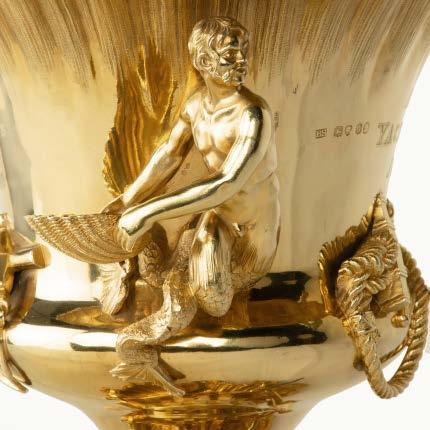
This large and impressive cup is in the form of a classical urn set on a capstan flanked by two anchors. The lip and base are moulded and incised to represent foaming waves. The body of the cup is applied with two tritons with bifurcated tails holding large scallop shell basins. There are two inscriptions reading ‘Royal Yacht Club 1829’ and ‘Won by Mr Assheton Smith’s Menai August 3rd 1829’ above beautifully rendered panoplies comprising ropes, anchors, compasses and buoys. Assay marks for Benjamin Smith, London, 1829.
Benjamin Smith (1764 - circa 1826) was a highly gifted silversmith who began his career as an "ingenious chaser", employed by Matthew Boulton. He moved to London in 1802 and collaborated with Digby Scott, Paul Storr and the renowned firm of Rundell & Bridge. Independently he created pieces for the Wellington Presentation Plate, notably a huge pair of candelabra, 1816, the Wellington Shield, 1822 and the Wellington Vase, 1824-5 (all at Apsley House, London). On a smaller scale, excelling in the production of silver salvers, trays, Grecian sugar bowls and elegant tea sets, he
Height: 10½ in (27cm)
Diameter: 10½ in (27cm)
created the Jamaica Service of 1803 for Lord Harewood (Royal Collection, Windsor).
Thomas Assheton Smith (1776-1858) was a founding member, in 1815, of The Yacht Club, (from 1833, The Royal Yacht Squadron). Heir to a great fortune founded on Welsh slate, Assheton Smith was able to pursue his passions for hunting, earning the accolade as the ‘foremost fox-hunter of his day’ and, in his youth, for cricket, appearing on several occasions for the ‘Gentlemen against the Players’ at Lord’s. However, the greater part of his fortune was spent saltwater racing. His cutter Menai , 163 tons, launched in 1826 and named for the stretch of water overlooked by his Welsh estate, took part in the inaugural Gold Cup race the same year, coming third. In the 1828 Cowes season Menai won the magnificent Southampton Ladies Regatta Cup which featured on pages 88-89 of Britain on the High Seas: From Nelson to Churchill (Wick Antiques, Lymington, 2019) and is now in the Royal Yacht Squadron. This cup from the subsequent year is evidence that Menai successfully defended her title.
100

101
The Lyme Regis & Charmouth Regatta Cup presented by John Attwood in 1846
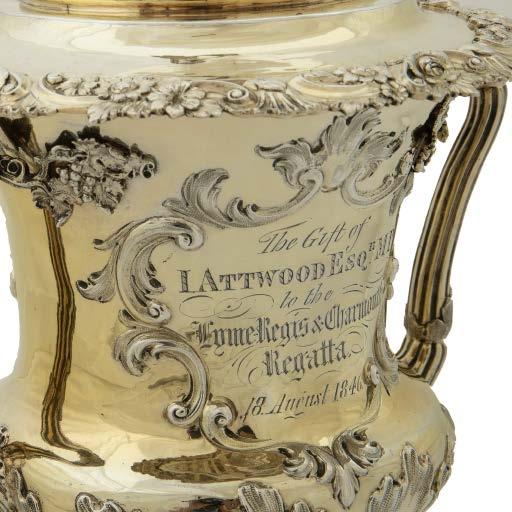
This large and ornate silver trophy was made by the famous silver and goldsmiths Hunt and Roskell. It is in the form of a classical footed urn with paired handles and a domed lid surmounted by a dolphin. The lid, lower body and foot are engraved throughout with collars of stippled waves. Each side has a central C-scroll cartouche, one stating ‘The Gift of I Attwood Esq.r MP to the Lyme Regis & Charmouth Regatta 18 August 1846’ and the other left blank. It is fully assayed and the rim is impressed ‘2786 Hunt & Roskell late Storr Mortimer & Hunt’ . English, 1846.
The Lyme Regis Regatta is believed to have been established around 1825. A report in the Exeter and Plymouth Gazette stated that the prize was “A silver cup, value 35 Guineas, presented by John Attwood Esq., M.P., for yachts not exceeding 35 tons. Old Admeasurement”.
John Attwood was the M.P. for Harwich in Essex and
Height: 13½ in ( 34cm)
Width: 8½ in (21.5cm)
Diameter: 6¼ in (16 cm)
Weight: 45 oz troy.
lived in a grand mansion, Hylands Park in Chelmsford. He made his fortune as the owner of an ironworks in Birmingham and then became a politician in 1841. However, accounts of the bribery used by his electoral agents led to him being forced out of parliament in 1848. Attwood had dreamed of getting a peerage, completing his journey from working man to gentleman, but died in disgrace and poverty in France hiding from his creditors in 1865.
Hunt and Roskell was a continuation of the firm set up by the great Paul Storr after leaving Rundell, Bridge and Rundell. Hunt and Roskell were the most important firm of silversmiths in the mid to late 19th century in London with royal warrants awarded by Queen Victoria and by the French Emperor. They won countless awards at the International Exhibitions held during this period, including the Great Exhibition of 1851.
102

103
Attributed to Thomas Sewell Robins: The Schooner Yacht America, 1851
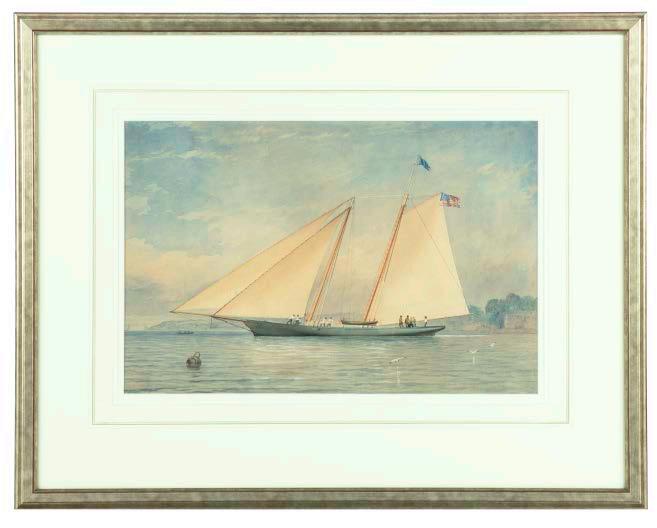
Height: 13½ in (34cm) Width: 8½ in (21.5cm) Diameter: 6¼ in (16 cm) Weight: 45 oz troy.
The full title of this watercolour on paper is ‘Thomas S. Robins, The Schooner Yacht ‘America’ at the time of her first race for the Queen’s Cup’ . It shows the famous yacht carrying two foresails and a mizzen, while a few crew members weigh the anchor and attend to the mainsail. A group of gentlemen in top hats and ladies in fully bustled crinolines stand in the stern in front of the helmsman. At the mizzen masthead the two flags flying are the Stars and Stripes and presumably the NYYC burgee. The reverse has two paper labels one for ‘The Quester Gallery, Greenwich, CT’ . English, circa 1851.
Provenance: Quester Gallery, Greenwich, CT.
Thomas Sewell Robins (1810-1880) was born in Devonport, Devon. Aged 19 he was admitted into the Royal Academy Schools under, James Northcote, a former pupil of Sir Joshua Reynolds, where his lecturers
included J. M. W. Turner. He was an early member of the New Watercolour Society and the Institute of Painters in Watercolours. Robins travelled extensively on the Continent and exhibited seven works at the RA, 39 at the British Institute, 21 at the Suffolk Street Galleries and 317 works at the New Watercolour Society. Robins is famous for his coastal marine subjects, working primarily in watercolours, and examples can be found in the Victoria and Albert Museum (London), Birmingham Museum and Art Gallery, the British Museum, the City of Portsmouth Museum, Cartwright Hall (Bradford), Howarth Museum and Gallery (Accrington), Newport Art Gallery, the Williamson Art Gallery and Museum (Birkenhead) and the National Maritime Museum (Greenwich).
See the following pages for a half hull model of America .
104
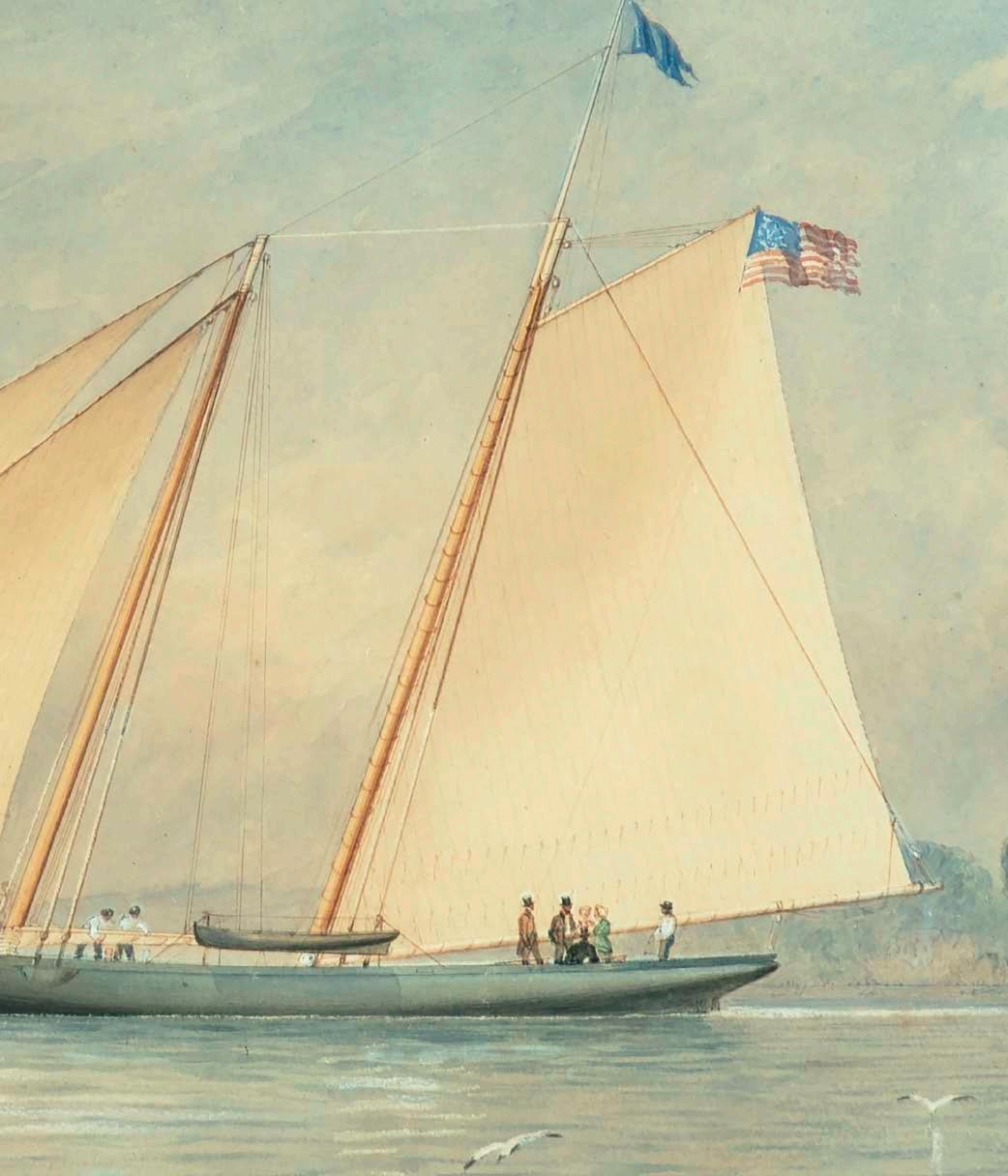
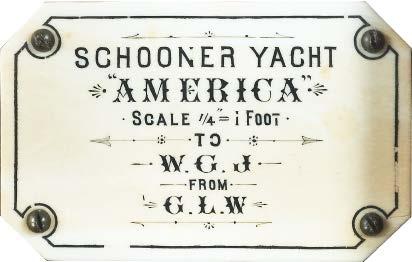
Case height: 11in (28cm) Length: 31in (79cm) Depth: 5in (12.5cm)
This cased presentation half hull model is of the first winner of the America’s Cup, the schooner America . The copper coloured bottom is painted with black topsides and has a finely carved garland around the bow. There are two stump masts, a caprail and bowsprit. It is set on a mahogany backboard with a Bakelite name plaque engraved ‘Schooner Yacht ‘America’ Scale ¼ = 1 foot to W.G.J. from G.L.W’ . A label identifies the case maker as ‘Lambert Picture Frame Manufacturer, 34 Albert Gate, Hyde Park, S.W.’ and another describes the model, including the fact that the case was added in 1903. It then explains the initials W.G.J. and G.L.W. ‘This model was presented by G.L.Watson to W.G.Jameson. George L.Watson was one of England’s leading yacht designers. He designed four America’s Cup Challengers which included: Thistle, Valkyrie, Valkyrie II and Shamrock II. He also designed the King’s Britannia, and the Kaiser’s Meteor. William G.Jameson was probably the most successful amateur helmsman in the U K in the 1880’s and the 1890’s. Jameson introduced Lord Dunraven to yacht racing in 1887. Dunraven was to build three challengers for the America’s Cup, all designed by G.L.Watson. Jameson in 1892 acted as an adviser to the Prince of Wales and introduced him to Watson who designed his Britannia. Jameson also advised Thomas Lipton in his Shamrock II challenge. Clearly, Watson and Jameson worked closely throughout their careers . Scottish, 1887.
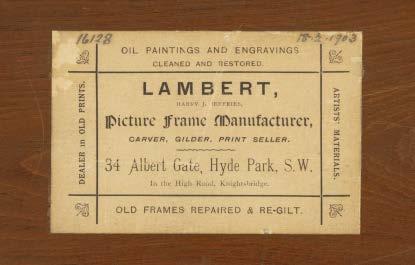
Provenance: 1887 William G. Jameson
The Glen Foster Collection
1999 Hyland Granby Antiques, Mass. 2002 The Kelton Collection
Probably the most famous racing yacht ever built, and the first winner of the America’s Cup, this schooner, designed by James and George Steers, was built by a syndicate of New York Yacht Club members to sail to England. The purpose of this visit was twofold: to show off U.S. shipbuilding skills and make money through competing in regattas. Only launched on 3rd May 1851, she had crossed the Atlantic and won the 53-mile race around the Isle of Wight by 22nd August that same year. America was captained by Richard Brown, who was a skilled member of the Sandy Hook Pilots group, renowned worldwide for their expertise and speed in manoeuvering schooner-rigged pilot boats. These vessels and crews had to be fast, for harbour pilots competed with each other for business. After a repeated cycle of successful competition followed by neglect, she was donated to the U.S. Naval Academy and became one of only three ships in commission in the U.S. Navy in both the Civil War and World War II.
This particular model was made by G. L. Watson and presented to William Jameson. Watson designed HMY Britannia for the Prince of Wales, but details of the
106
A presentation model of America’s Cup winner America by
G. L. Watson
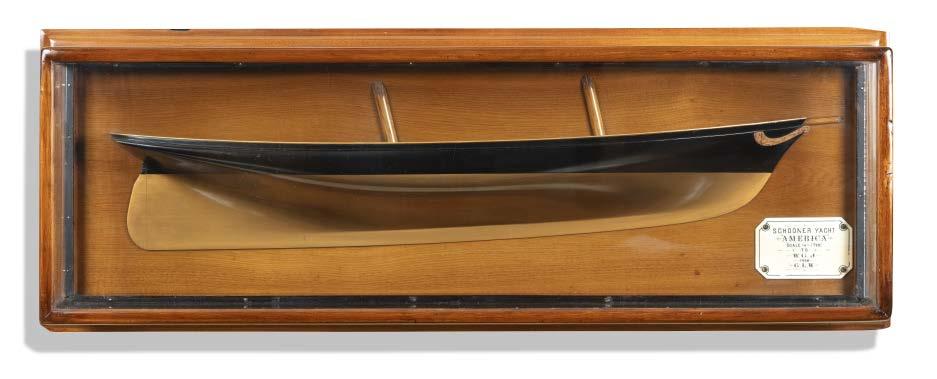
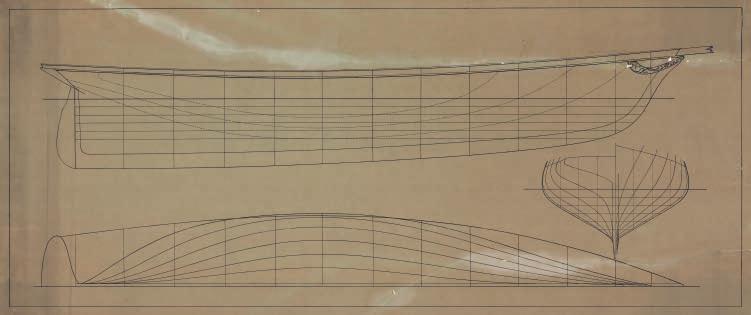
commission were arranged on the Prince’s behalf by William Jameson who liaised closely with Watson. Britannia was the most famous and successful British racing yacht of her time, and sister-ship Valkyrie II , was Challenger for the 1893 America's Cup.
We are indebted to Dr William Collier, Managing Director of G. L. Watson & Co. Ltd, whose research has unearthed both this drawing of plans of America’s hull
and Watson’s own notebook on Britannia , or design No. 270, as she was then. The first entry reads ‘Racing Cutter 87ft [waterline length] per W G Jamieson’ followed by ‘Note of costs as given to the Prince of Wales’ , the total was £8,300. The drawing is one of a series that were made for models and there is at least one other of America made at the same time and given as a thank you present in connection with the Valkyrie II challenge.
107
Image courtesy of G. L. Watson & Co. Ltd / Scottish Yachting Archives.
A

This large yachting trophy is in the form of a punch bowl with two loop handles. It is raised on a turned support and flaring foot. One side is engraved with a coat-ofarms surmounted by a three-masted barque and the Latin motto ‘Disce Pati’ (Learn to Suffer). There is restrained decoration with bands of interlinked roundels to the rim and stem, and low relief foliate strapwork on the foot. The handles are embossed with classical masks. The underside is engraved and stamped ‘Tiffany & Co 2026, Quality 925/1000, 3218, 550 Broadway with M director mark’ and ‘To David Duncan from His Guests of Race Week August 1868’ with 12 names (probably members of the NYYC), including the notable high society figures W.W. Sherman, S.E. Peabody, W.G. Saltonstall, P. Schuyler, etc. William Gurdon Saltonstall (1831-1889) was an American naval officer from Salem. during the US
Civil War and a prominent merchant; Samuel Endicott Peabody (1825-1909) was an American merchant and banker who was a partner in the London banking firm of J.S. Morgan & Co; William Watts Sherman (1842-1912) was a New York City businessman and the treasurer of the Newport Casino. Philip Schuyler was the son of George Lee Schuyler, a founding member of the NYYC in 1844 (the second oldest in North America). George helped create the syndicate that built and raced the great schooner-yacht America and played a key role in the founding of the America's Cup Regatta.
See the previous pages for a portrait and a half hull model of America. Drawings from the July edition of Harper’s Magazine in 1871 show NYYC trophies which include a very similar cup, No.6., described as a punch bowl.
108
sterling silver New York Yacht Club Trophy by Tiffany & Co., 1868
From Harper’s Magazine, 1871.

Height: 13¼ in (34cm)
Width: 16 in (41cm)
Bowl diameter: 11¼ in (28.5cm)
Weight: 72.9 oz troy
109
New York Yacht Club Regatta ewer by Tiffany won by sloop Gracie, 1872

This sterling silver ewer, based on the ancient Greek Oenochoe form of wine jug, has a bulbous body and a hinged lid. It is applied with a coiled rope and anchor finial. The gadrooned arched handle terminates in a Neptune mask suspended from a twisted rope which encircles the shoulder. A large central garland of oak leaves, denoting triumph and victory, encloses the inscription ‘First prize for Sloops without time allowance won by Gracie, New York Yacht Club Regatta, 20th June 1872’. Fully marked to the base for John C Moore & Son, sterling silver and Tiffany & Co, with their Union Square address.
Provenance: Samuel J. Colgate, owner of Gracie.
Published: Harpers magazine, July 8, 1871, p.625 (see previous pages).
Gracie was built at Nyack on the Hudson river in 1868. Designed by A. G. Polhemus for William Voorhis, she had a stellar career for 42 years and won numerous regattas, private challenge cups and even races against America's Cup contenders. Gracie entered the 1872 NYYC Regatta sloop class against Vixen, Addie and Ariadne; and won by 5 minutes, 12 seconds. In 1881 she beat both the selected defender of the America’s Cup and the challenger in a three way contest and the fact that she was never selected to compete in the Cup race itself was a source of considerable controversy in the racing world. She was described by Brentano's Aquatic Monthly and Sporting Gazetteer in the following glowing terms ‘No yacht at the present day is better known, or more appreciated, or more successful, than the sloopyacht Gracie, which has been selected by the New York Yacht Club to carry the Rear-Commodore's pennant for 1879’.
The
110

Height: 11½in (29cm)
Width: 8in (20cm)
Depth: 7in (18cm)
Weight: 59.12oz
111
A
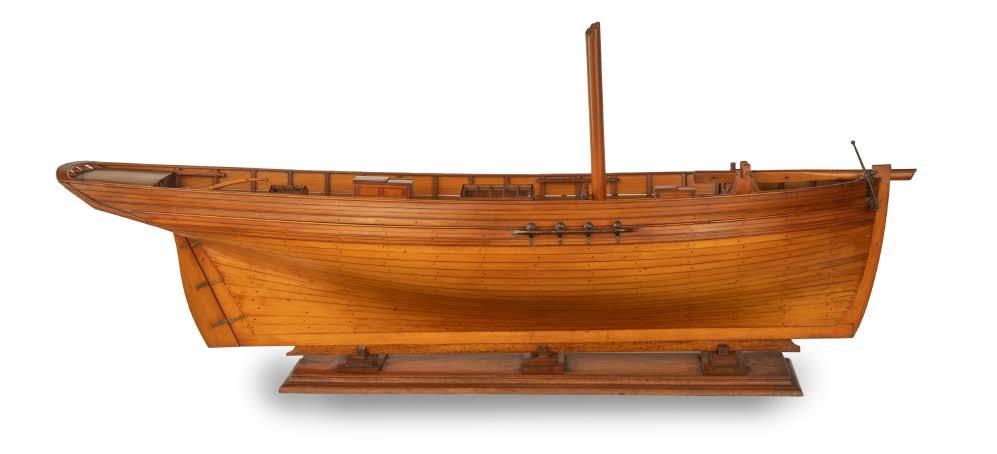
This large boxwood model has a truncated mast and retractable bowsprit. The hull has an upright stem, wide beam, four metal rigging blocks on each side and a single anchor in the bow. The deck has two sets of glass sky lights, two covered companionways, belaying pins and
two capstans, one for the anchor and the other for the bowsprit. The finely carved tiller has a knotted rope terminal and controls the working rudder. It is raised on a fitted stand with three brackets. English, circa 1860.
112
Victorian shipyard model of a sloop
Height: 23½ in (60cm) Width: 54¼ in (138cm) Depth: 12½ in (32cm)

113
Thomas Willis: Shamrock III and Reliance Crossing the Line, America's Cup, 1903
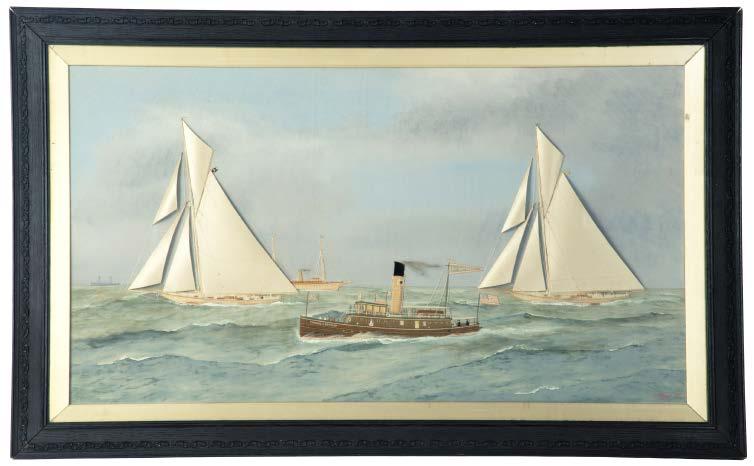
This mixed media picture is oil on canvas with silk and velvet fabric embroidered with silk thread. It shows the 1903 America's Cup yacht race outside New York Harbour between Reliance and Shamrock III. The spectator boat Edward J. Bergwind occupies the centre of the picture. The scene is meticulously detailed with stitched silk rigging, a velvet hull overlaid with silk to depict the spray of the waves and a velvet smokestack with a tuft of silk streaming behind as smoke. Signed and dated ‘T. Willis, N.Y., 1904’ American.
Provenance: The daughter of the tugboat’s owner and thence by descent.
Thomas Willis (1850-1925) was a successful New York silk merchant. When he became an artist in 1880, he incorporated his knowledge of silk textiles into his creations. He was commissioned by the New York Yacht Club to produce ship portraits and thus became the artist of choice for many wealthy owners.
As well as the unusual mixture of oil paint and fabric used to create this image, the composition is striking. Paintings of America’s Cup races normally focus on the racing yachts and yet the vessel depicted front and centre of this piece is the steam tug, Edward J. Berwind, owned by BerwindWhite Coal Company. Edward Julius Berwind (18481936) was the founder of the Berwind-White Coal Mining Company. Having served in the US Navy, he was a naval aide at the White House during the Grant administration, a philanthropist, a lifelong friend of King Edward VII and a member of the New York Yacht Club.
When this picture was discovered on the American Antiques Roadshow the guest said it had been commissioned from Thomas Willis by her forebears, as her maternal great-great-grandfather owned tugboat companies in the New York Harbour at that time. The appraiser is recorded saying ‘This is far and away superior to any work by this artist we've seen. I think this was Thomas Willis's masterpiece’.
114
Canvas height: 20 in (51 cm) Width: 36 in (91.5cm) Framed height: 26 in (66cm) Width: 42 in (107cm)

A life ring from the America’s Cup yacht Shamrock, Royal Ulster Yacht Club, 1899
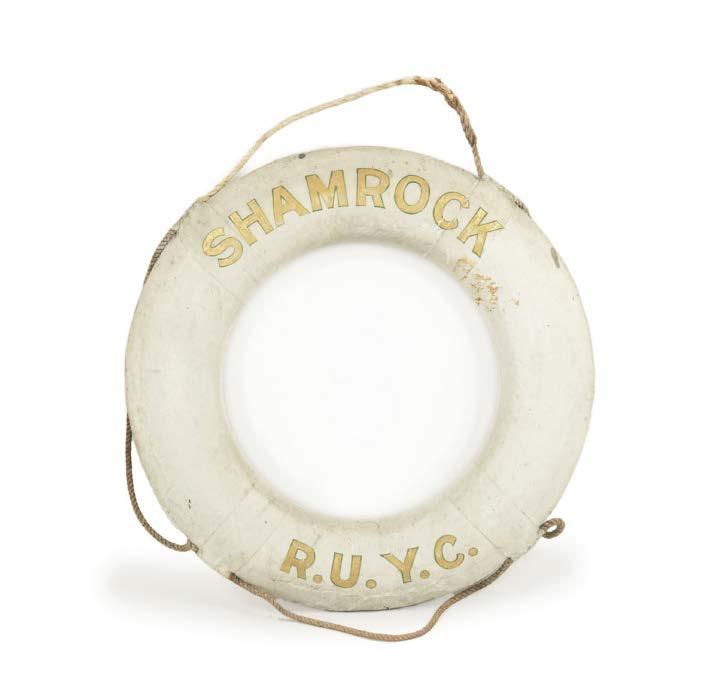
This is an original life ring from the first of Sir Thomas Lipton’s America’s Cup challengers called Shamrock . The circular ring is painted in gilt outlined in green ‘Shamrock, R.U.Y.C.’ , on a white ground, with the original rope handles threaded through canvas straps. English, 1899.
Sir Thomas Lipton (1848-1931) was born in Glasow to Irish parents who ran a small grocery shop. From these humble beginnings he founded a chain of more than 300 stores throughout the U.K. and built up a considerable monopoly in the tea trade. Having amassed a fortune in a very short space of time, he challenged for the America’s Cup no fewer than five times between 1899 and 1930 (see previous and opposite pages). The first Shamrock lost in three races to the New York Yacht
Club’s Columbia . By the fifth series in 1930, the races were contested in international J-class yachts. These cost half-million dollars or more, an exorbitant sum during the Great Depression. In this final challenge Enterprise , skippered by Harold Vanderbilt, won the first two races easily, but in the third Shamrock V was leading until she lost her main halyard and had to be towed back to port. In the fourth race Enterprise won by nearly 6 minutes and so retained the Cup. The 1920 challenge was the only one in which one of Lipton's yachts, Shamrock IV , managed a modicum of success, winning two races in the best-of-five series. Despite this, Lipton was so gracious in defeat that the mayor of New York once described him as ‘possibly the world's worst yacht builder, but absolutely the world's most cheerful loser.’
116
Diameter: 30¾ in (77cm)
Harold Wyllie: Shamrock V and Enterprise racing for the America’s Cup, 1930

The 1930 America’s Cup was contested by J-class yachts off Newport, Rhode Island. This painting shows Enterprise (white hull sail number 4) pulling ahead of Shamrock V (green hull, sail number J/K3) amongst a flotilla of boats probably including the private steam yacht of Harold Vanderbilt Corsaire , a passenger ferry crowded with spectators and other day boats. Oil on canvas, signed ‘Harold Wyllie’ , in a moulded giltwood frame. English, circa 1930.
Provenance: Deaccessioned from the Ulster Museum, Belfast.
Harold Wyllie (1880-1973) was the eldest son of William Lionel Wyllie (see pages 84-85). He studied under his father and was particularly interested in the development of the sailing ship and devoted himself to in-depth research eventually becoming a recognised expert on the subject. He exhibited at the Royal Institute, the Royal Academy and was a founding member of the Royal Society of Marine Artists, becoming vice-president in 1958. He served as Honourable Marine Painter to the Royal Yacht Squadron, Cowes, from 1934-1946, although only a handful of his yachting paintings in oil are known to exist. This is the only one of the America's Cup as far as we are aware.
117
Height: 28
Width: 36 in (91.5cm) Framed height: 34 in (86.5cm) Width: 42 in (106.5cm)
in (71cm)
Montague Dawson: Taking in the Jib

This charming watercolour and gouache on paper shows a gaff-rigged dayboat with a royal blue hull surfing over a wave as the foredeck hand gathers the jib. There is a buoy in the foreground and a ketch sailing away in the distance. Signed ‘Montague Dawson’ . English, circa 1930.
Provenance: Sold Sotheby’s London, May 11, 1994.
Montague Dawson RMSA, FRSA (1890–1973) was the son of a keen yachtsman and the grandson of the marine painter Henry Dawson (1811–1878). He served in the Dazzle Painting Section at Leith in WWI and 1924 was the official artist for an Expedition to the South Seas by the steam yacht St.George . He was present at the final
surrender of the German High Seas Fleet and many of his illustrations depicting the event were published in The Sphere . After the war, Dawson established himself as a professional marine artist, concentrating on historical subjects and portraits of deep-water sailing ships often in a stiff breeze or on high seas. During WWII he was once again employed as a war artist and again worked for The Sphere . He exhibited regularly at the Royal Society of Marine Artists, of which he was a member, from 1946 to 1964, and occasionally at the Royal Academy between 1917 and 1936. He was considered one of the greatest living marine artists, whose patrons included two American Presidents, Dwight Eisenhower and Lyndon Johnson, as well as the British Royal Family.
118
Height: 16½ in (42cm) Width: 26 in (66 cm)

119
All measurements are approximate.
Any items containing ivory will require an export licence. Further information on many items in this catalogue can be found at www.wickantiques.co.uk
Very important pieces may also feature in our blogs in the media section. We would like to thank Christopher Coles for his additional research.
Catalogue
Photography: Chris Challis | Emma Van Lindholm | Simon Heron
120 Notes
Design: Steve Hayes | Printed by: Blackmore Ltd




www.wickantiques.co.uk
 CHARLES WALLROCK
CHARLES WALLROCK





 Heroic Endeavour
Heroic Endeavour











































 Cabin plan height: 26 in (65cm) Width: 40 in (101.5cm)
Cabin plan height: 26 in (65cm) Width: 40 in (101.5cm)





















































 Queen Victoria by Franz Xavier Winterhalter, circa 1840.
Queen Victoria by Franz Xavier Winterhalter, circa 1840.




























































